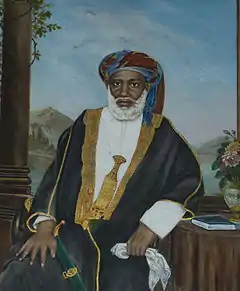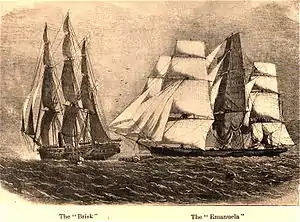Slavery in Africa
Slavery has historically been widespread in Africa. Systems of servitude and slavery were common in parts of Africa in ancient times, as they were in much of the rest of the ancient world.[1] When the trans-Saharan slave trade, Indian Ocean slave trade and Atlantic slave trade (which started in the 16th century)[2] began, many of the pre-existing local African slave systems began supplying captives for slave markets outside Africa.[3][4]
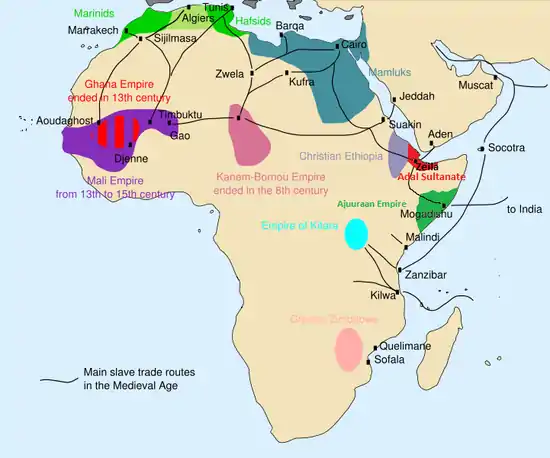
| Part of a series on |
| Slavery |
|---|
 |
Slavery in historical Africa was practised in many different forms: Debt slavery, enslavement of war captives, military slavery, slavery for prostitution, and criminal slavery were all practised in various parts of Africa.[5] Slavery for domestic and court purposes was widespread throughout Africa.[6] Plantation slavery also occurred, primarily on the eastern coast of Africa and in parts of West Africa.[7] The importance of domestic plantation slavery increased during the 19th century, due to the abolition of the Atlantic slave trade.[8] Many African states dependent on the international slave trade reoriented their economies towards legitimate commerce worked by slave labor.[9][10]
Forms of slavery
Multiple forms of slavery and servitude have existed throughout African history, and were shaped by indigenous practices of slavery as well as the Roman institution of slavery [11] (and the later Christian views on slavery), the Islamic institutions of slavery via the Muslim slave trade, and eventually the Atlantic slave trade.[12][4] Slavery was a part of the economic structure of African societies for many centuries, although the extent varied.[13][4] Ibn Battuta, who visited the ancient kingdom of Mali in the mid-14th century, recounts that the local inhabitants vied with each other in the number of slaves and servants they had, and was himself given a slave boy as a "hospitality gift."[14] In sub-Saharan Africa, the slave relationships were often complex, with rights and freedoms given to individuals held in slavery and restrictions on sale and treatment by their masters.[15] Many communities had hierarchies between different types of slaves: for example, differentiating between those who had been born into slavery and those who had been captured through war.[16]
Travels in the Interior of Africa, Mungo Park, Travels in the Interior of Africa v. II, Chapter XXII – War and Slavery.
The forms of slavery in Africa were closely related to kinship structures.[17] In many African communities, where land could not be owned, enslavement of individuals was used as a means to increase the influence a person had and expand connections.[18] This made slaves a permanent part of a master's lineage, and the children of slaves could become closely connected with the larger family ties.[19][4] Children of slaves born into families could be integrated into the master's kinship group and rise to prominent positions within society, even to the level of chief in some instances.[16] However, stigma often remained attached, and there could be strict separations between slave members of a kinship group and those related to the master.[18]
Chattel slavery
Chattel slavery is a specific servitude relationship where the slave is treated as the property of the owner.[20] As such, the owner is free to sell, trade, or treat the slave as he would other pieces of property, and the children of the slave often are retained as the property of the master.[21] There is evidence of long histories of chattel slavery in the Nile River valley, much of the Sahel and North Africa, but evidence is incomplete about the extent and practices of chattel slavery throughout much of the rest of the continent prior to written records by Arab or European traders though it was likely common and widely abusive, given current evidence.[21][22]
Domestic service
Many slave relationships in Africa revolved around domestic slavery, where slaves would work primarily in the house of the master, but retain some freedoms.[23] Domestic slaves could be considered part of the master's household and would not be sold to others without extreme cause.[24] The slaves could own the profits from their labour (whether in land or in products), and could marry and pass the land on to their children in many cases.[16][25]
Pawnship
Pawnship, or debt bondage slavery, involves the use of people as collateral to secure the repayment of debt.[26] Slave labor is performed by the debtor, or a relative of the debtor (usually a child).[27] Pawnship was a common form of collateral in West Africa.[28] It involved the pledge of a person or a member of that person's family, to serve another person providing credit.[29] Pawnship was related to, yet distinct from, slavery in most conceptualizations, because the arrangement could include limited, specific terms of service to be provided,[30] and because kinship ties would protect the person from being sold into slavery.[30] Pawnship was a common practice throughout West Africa prior to European contact, including among the Akan people, the Ewe people, the Ga people, the Yoruba people, and the Edo people [31](in modified forms, it also existed among the Efik people, the Igbo people, the Ijaw people, and the Fon people).[32][33][34]
Military slavery
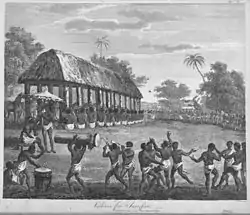
Military slavery involved the acquisition and training of conscripted military units which would retain the identity of military slaves even after their service.[35] Slave soldier groups would be run by a Patron, who could be the head of a government or an independent warlord, and who would send his troops out for money and his own political interests.[35]
This was most significant in the Nile valley (primarily in Sudan and Uganda), with slave military units organized by various Islamic authorities,[35] and with the war chiefs of Western Africa.[36] The military units in Sudan were formed in the 1800s through large-scale military raiding in the area which is currently the countries of Sudan and South Sudan.[35]
Moreover, a considerable number of the men born between 1800 and 1849 in West African regions (today Ghana and Burkina Faso) and abducted as slaves to serve in the army in Dutch Indonesia.[37] Interestingly, soldiers were on average 3 cm taller than other West African population.[38] Furthermore, data showed, West Africans were shorter than North Europeans but of almost equal height to South Europeans.[39] This was mainly related to the quality of the nutrition and healthcare.[40]
Slaves for sacrifice
Human sacrifice was common in West African states up to and during the 19th century.[41][42] Although archaeological evidence is not clear on the issue prior to European contact, in those societies that practiced human sacrifice, slaves became the most prominent victims.[43][4]
The Annual Customs of Dahomey were the most notorious example of the human sacrifice of slaves, where 500 prisoners would be sacrificed.[44] Sacrifices were carried out all along the West African coast and further inland.[45] Sacrifices were common in the Benin Empire, in what is now Ghana, and in the small independent states in what is now southern Nigeria.[46] In the Ashanti Region, human sacrifice was often combined with capital punishment.[47][48][49]
Local slave trade
Many nations such as the Bono State, Ashanti of present-day Ghana and the Yoruba of present-day Nigeria were involved in slave-trading.[50] Groups such as the Imbangala of Angola and the Nyamwezi of Tanzania would serve as intermediaries or roving bands, waging war on African states to capture people for export as slaves.[51] Historians John Thornton and Linda Heywood of Boston University have estimated that of the Africans captured and then sold as slaves to the New World in the Atlantic slave trade,[52] around 90% were enslaved by fellow Africans who sold them to European traders.[53] Henry Louis Gates, the Harvard Chair of African and African American Studies, has stated that "without complex business partnerships between African elites and European traders and commercial agents,[54] the slave trade to the New World would have been impossible, at least on the scale it occurred."[53]
The entire Bubi ethnic group descends from escaped intertribal slaves owned by various ancient West-central African ethnic groups.[55]
Slavery practices throughout Africa
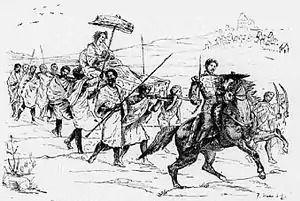
Like most other regions of the world, slavery and forced labor existed in many kingdoms and societies of Africa for hundreds of years.[56][15] According to Ugo Kwokeji, early European reports of slavery throughout Africa in the 1600s are unreliable because they often conflated various forms of servitude as equal to chattel slavery.[57]
The best evidence of slave practices in Africa come from the major kingdoms, particularly along the coast, and there is little evidence of widespread slavery practices in stateless societies.[4][15][16] Slave trading was mostly secondary to other trade relationships; however, there is evidence of a trans-Saharan slave trade route from Roman times which persisted in the area after the fall of the Roman Empire.[21] However, kinship structures and rights provided to slaves (except those captured in war) appears to have limited the scope of slave trading before the start of the trans-Saharan slave trade, Indian Ocean slave trade and the Atlantic slave trade.[15]
North Africa
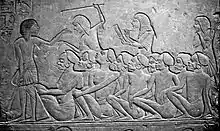
Slavery in northern Africa dates back to ancient Egypt. The New Kingdom (1558–1080 BC) brought in large numbers of slaves as prisoners of war up the Nile valley and used them for domestic and supervised labor.[58][59] Ptolemaic Egypt (305 BC–30 BC) used both land and sea routes to bring slaves in.[60][61]
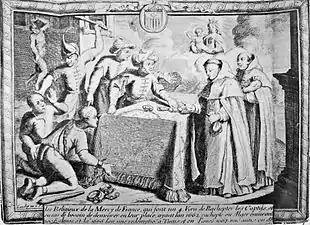
_-_Copy.jpg.webp)
Chattel slavery had been legal and widespread throughout North Africa when the region was controlled by the Roman Empire (145 BC – ca. 430 AD), and by the Eastern Romans from 533 to 695).[63] A slave trade bringing Saharans through the desert to North Africa,[64] which existed in Roman times, continued and documentary evidence in the Nile Valley shows it to have been regulated there by treaty.[21] As the Roman republic expanded, it enslaved defeated enemies and Roman conquests in Africa were no exception.[65] For example, Orosius records that Rome enslaved 27,000 people from North Africa in 256 BC.[66] Piracy became an important source of slaves for the Roman Empire and in the 5th century AD pirates would raid coastal North African villages and enslave the captured.[67] Chattel slavery persisted after the fall of the Roman Empire in the largely Christian communities of the region.[68] After the Islamic expansion into most of the region because of the trade expansion across the Sahara,[69] the practices continued and eventually, the assimilative form of slavery spread to major societies on the southern end of the Sahara (such as Mali, Songhai, and Ghana).[70][4] The medieval slave trade in Europe was mainly to the East and South: the Christian Byzantine Empire and the Muslim World were the destinations, Central and Eastern Europe an important source of slaves.[71][72] Slavery in medieval Europe was so widespread that the Roman Catholic Church repeatedly prohibited it—or at least the export of Christian slaves to non-Christian lands was prohibited at, for example, the Council of Koblenz in 922, the Council of London in 1102, and the Council of Armagh in 1171.[73] Because of religious constraints, the slave trade was carried out in parts of Europe by Iberian Jews (known as Radhanites) who were able to transfer slaves from pagan Central Europe through Christian Western Europe to Muslim countries in Al-Andalus and Africa.[74][75]
The Mamluks were slave soldiers who converted to Islam and served the Muslim caliphs and the Ayyubid Sultans during the Middle Ages. The first Mamluks served the Abbasid caliphs in 9th century Baghdad.[76] Over time, they became a powerful military caste, and on more than one occasion they seized power for themselves, for example, ruling Egypt from 1250 to 1517.[77] From 1250 Egypt had been ruled by the Bahri dynasty of Kipchak Turk origin.[78] White enslaved people from the Caucasus served in the army and formed an elite corps of troops, eventually revolting in Egypt to form the Burgi dynasty.[79] According to Robert Davis between 1 million and 1.25 million Europeans were captured by Barbary pirates and sold as slaves to North Africa and the Ottoman Empire between the 16th and 19th centuries.[80][81] However, to extrapolate his numbers, Davis assumes the number of European slaves captured by Barbary pirates were constant for a 250-year period, stating:
"There are no records of how many men, women and children were enslaved, but it is possible to calculate roughly the number of fresh captives that would have been needed to keep populations steady and replace those slaves who died, escaped, were ransomed, or converted to Islam. On this basis, it is thought that around 8,500 new slaves were needed annually to replenish numbers - about 850,000 captives over the century from 1580 to 1680. By extension, for the 250 years between 1530 and 1780, the figure could easily have been as high as 1,250,000."[82]
Davis' numbers have been disputed by other historians, such as David Earle, who cautions that the true picture of European slaves is clouded by the fact the corsairs also seized non-Christian whites from eastern Europe and black people from West Africa.[82]
In addition, the number of slaves traded was hyperactive, with exaggerated estimates relying on peak years to calculate averages for entire centuries, or millennia.[83][84] Hence, there were wide fluctuations year-to-year, particularly in the 18th and 19th centuries, given slave imports, and also given the fact that, prior to the 1840s, there are no consistent records.[85] Middle East expert John Wright cautions that modern estimates are based on back-calculations from human observation.[86]
Such observations, across the late 1500s and early 1600s observers, estimate that around 35,000 European Christian slaves held throughout this period on the Barbary Coast, across Tripoli, Tunis, but mostly in Algiers.[87] The majority were sailors (particularly those who were English), taken with their ships, but others were fishermen and coastal villagers. However, most of these captives were people from lands close to Africa, particularly Spain and Italy.[88]
The coastal villages and towns of Italy, Portugal, Spain, and Mediterranean islands were frequently attacked by the pirates, and long stretches of the Italian and Spanish coasts were almost completely abandoned by their inhabitants;[89] after 1600 Barbary pirates occasionally entered the Atlantic and struck as far north as Iceland.[90] The most famous corsairs were the Ottoman Barbarossa ("Redbeard"), and his older brother Oruç, Turgut Reis (known as Dragut in the West), Kurtoğlu (known as Curtogoli in the West), Kemal Reis, Salih Reis, and Koca Murat Reis.[81][91]
In 1544, Hayreddin Barbarossa captured Ischia, taking 4,000 prisoners in the process, and deported to slavery some 9,000 inhabitants of Lipari, almost the entire population.[92] In 1551, Dragut enslaved the entire population of the Maltese island Gozo, between 5,000 and 6,000, sending them to Libya. When pirates sacked Vieste in southern Italy in 1554 they took an estimated 7,000 slaves. In 1555, Turgut Reis sailed to Corsica and ransacked Bastia, taking 6,000 prisoners.[93] In 1558 Barbary corsairs captured the town of Ciutadella, destroyed it, slaughtered the inhabitants, and carried off 3,000 survivors to Istanbul as slaves.[94] In 1563 Turgut Reis landed at the shores of the province of Granada, Spain, and captured the coastal settlements in the area like Almuñécar, along with 4,000 prisoners. Barbary pirates frequently attacked the Balearic islands, resulting in many coastal watchtowers and fortified churches being erected. The threat was so severe that Formentera became uninhabited.[95][96]
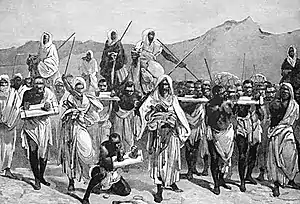
Early modern sources are full of descriptions of the sufferings of Christian galley slaves of the Barbary corsairs:
Those who have not seen a galley at sea, especially in chasing or being chased, cannot well conceive the shock such a spectacle must give to a heart capable of the least tincture of commiseration. To behold ranks and files of half-naked, half-starved, half-tanned meagre wretches, chained to a plank, from whence they remove not for months together (commonly half a year), urged on, even beyond human strength, with cruel and repeated blows on their bare flesh...[97]
As late as 1798, the islet near Sardinia was attacked by the Tunisians and over 900 inhabitants were taken away as slaves.
Sahrawi-Moorish society in Northwest Africa was traditionally (and still is, to some extent) stratified into several tribal castes,[98] with the Hassane warrior tribes ruling and extracting tribute – horma – from the subservient Berber-descended znaga tribes.[99] Below them ranked servile groups known as Haratin, a black population.[100]
Enslaved Sub-Saharan Africans were also transported across North Africa into Arabia to do agricultural work because of their resistance to malaria that plagued the Arabia and North Africa at the time of early enslavement.[101] Sub-Saharan Africans were able to endure the malaria-infested lands they were transported to, which is why North Africans were not transported despite their close proximity to Arabia and its surrounding lands.[102]
Horn of Africa
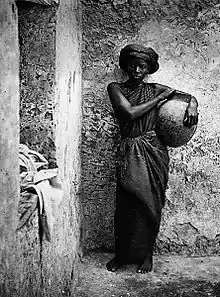
In the Horn of Africa, the Christian kings of the Ethiopian Empire often exported pagan Nilotic slaves from their western borderlands, or from newly conquered or reconquered lowland territories.[103][104] The Somali and Afar Muslim sultanates, such as the medieval Adal Sultanate, through their ports also traded Zanj (Bantu) slaves who were captured from the hinterland.[105][106]
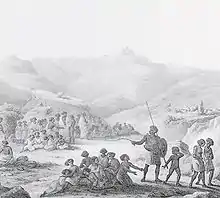
Slavery, as practiced in Ethiopia, was essentially domestic and was geared more towards women; this was the trend for most of Africa as well.[107] Women were transported across the Sahara, the Middle East, and the Mediterranean and the Indian Ocean trade more than men.[108][109] Enslaved people served in the houses of their masters or mistresses, and were not employed to any significant extent for productive purpose.[110] The enslaved were regarded as second-class members of their owners' family.[111] The first attempt to abolish slavery in Ethiopia was made by Emperor Tewodros II (r. 1855–68),[112] although the slave trade was not abolished legally until 1923 with Ethiopia's ascension to the League of Nations.[113] Anti-Slavery Society estimated there were 2 million slaves in the early 1930s, out of an estimated population of between 8 and 16 million.[114][115] Slavery continued in Ethiopia until the Italian invasion in October 1935, when the institution was abolished by order of the Italian occupying forces.[116] In response to pressure by Western Allies of World War II, Ethiopia officially abolished slavery and involuntary servitude after having regained its independence in 1942.[117][118] On 26 August 1942, Haile Selassie issued a proclamation outlawing slavery.[119]
In Somali territories, slaves were purchased in the slave market exclusively to do work on plantation grounds.[120] In terms of legal considerations, the customs regarding the treatment of Bantu slaves were established by the decree of Sultans and local administrative delegates.[121] Additionally, freedom for these plantation slaves was also often acquired through eventual emancipation, escape, and ransom.[120]
Central Africa
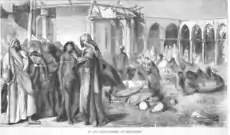
.jpg.webp)
Oral tradition recounts slavery existing in the Kingdom of Kongo from the time of its formation with Lukeni lua Nimi enslaving the Mwene Kabunga whom he conquered to establish the kingdom.[122] Early Portuguese writings show that the Kingdom did have slavery before contact, but that they were primarily war captives from the Kingdom of Ndongo.[122][123]
Slavery was common along the Upper Congo River, and in the second half of the 18th century the region became a major source of slaves for the Atlantic Slave Trade,[124] when high slave prices on the coast made long-distance slave trading profitable.[125] When the Atlantic trade came to an end, the prices of slaves dropped dramatically, and the regional slave trade grew, dominated by Bobangi traders.[126] The Bobangi also purchased a large number of slaves with profits from selling ivory, who they used to populate their villages.[127] A distinction was made between two different types of slaves in this region; slaves who had been sold by their kin group, typically as a result of undesirable behavior such as adultery, were unlikely to attempt to flee.[128] In addition to those considered socially undesirable, the sale of children was also common in times of famine.[129] Slaves who were captured, however, were likely to attempt to escape and had to be moved hundreds of kilometers from their homes as a safeguard against this.[130][131]
The slave trade had a profound impact on this region of Central Africa, completely reshaping various aspects of society.[132] For instance, the slave trade helped to create a robust regional trade network for the foodstuffs and crafted goods of small producers along the river.[3] As the transport of only a few slaves in a canoe was sufficient to cover the cost of a trip and still make a profit,[133] traders could fill any unused space on their canoes with other goods and transport them long distances without a significant markup on price.[134] While the large profits from the Congo River slave trade only went to a small number of traders, this aspect of the trade provided some benefit to local producers and consumers.[135]
West Africa
_%22Guinea%22_-_Geographicus_-_Aethiopia-hmhr-1743.jpg.webp)
Various forms of slavery were practiced in diverse ways in different communities of West Africa prior to European trade.[7][56] Even though slavery did exist, it was not nearly as prevalent within most West African societies that were not Islamic before the Trans-Atlantic Slave Trade.[136][137][138] The prerequisites for slave societies to exist weren't present in West Africa prior to the Atlantic slave trade considering the small market sizes and the lack of a division of labor.[3][137] Most West African societies were formed in Kinship units which would make slavery a rather marginal part of the production process within them.[139][4] Slaves within Kinship-based societies would have had almost the same roles that free members had.[140][4] Martin Klein has said that before the Atlantic trade, slaves in Western Sudan “made up a small part of the population, lived within the household, worked alongside free members of the household, and participated in a network of face-to-face links.”[141][137] With the development of the trans-Saharan slave trade and the economies of gold in the western Sahel, a number of the major states became organized around the slave trade, including the Ghana Empire, the Mali Empire, the Bono State and Songhai Empire.[142][143] However, other communities in West Africa largely resisted the slave trade.[132] The Jola refused to participate in the slave trade up into the end of the seventeenth century, and didn't use slave labor within their own communities until the nineteenth century.[144] The Kru and Baga also fought against the slave trade.[145] The Mossi Kingdoms tried to take over key sites in the trans-Saharan trade and, when these efforts failed, the Mossi became defenders against slave raiding by the powerful states of the western Sahel.[146] The Mossi would eventually enter the slave trade in the 1800s with the Atlantic slave trade being the main market.[126][143]
Senegal was a catalyst for slave trade, and from the Homann Heirs map figure shown, shows a starting point for migration and a firm port of trade.[147] The culture of the Gold Coast was based largely on the power that individuals held, rather than the land cultivated by a family.[148] Western Africa, and specifically places like Senegal, were able to arrive at the development of slavery through analyzing the aristocratic advantages of slavery and what would best suit the region.[149] This sort of governing that used "political tool" of discerning the different labors and methods of assimilative slavery.[150] The domestic and agricultural labor became more evidently primary in Western Africa due to slaves being regarded as these "political tools" of access and status.[151] Slaves often had more wives than their owners, and this boosted the class of their owners.[152] Slaves were not all used for the same purpose. European colonizing countries were participating in the trade to suit the economic needs of their countries.[153] The parallel of "Moorish" traders found in the desert compared to the Portuguese traders that were not as established pointed out the differences in uses of slaves at this point, and where they were headed in the trade.[154]
Historian Walter Rodney identified no slavery or significant domestic servitude in early European accounts on the Upper Guinea region[16] and I. A. Akinjogbin contends that European accounts reveal that the slave trade was not a major activity along the coast controlled by the Yoruba people and Aja people before Europeans arrived.[155] In a paper read to the Ethnological Society of London in 1866, the viceroy of Lokoja Mr T. Valentine Robins, who in 1864 accompanied an expedition up the River Niger aboard HMS Investigator, described slavery in the region:
Upon slavery Mr Robins remarked that it was not what people in England thought it to be. It means, as continually found in this part of Africa, belonging to a family group-there is no compulsory labour, the owner and the slave work together, eat like food, wear like clothing and sleep in the same huts. Some slaves have more wives than their masters. It gives protection to the slaves and everything necessary for their subsistence - food and clothing. A free man is worse off than a slave; he cannot claim his food from anyone.[156]
With the beginning of the Atlantic slave trade, demand for slavery in West Africa increased and a number of states became centered on the slave trade and domestic slavery increased dramatically.[157] Hugh Clapperton in 1824 believed that half the population of Kano were enslaved people.[158]
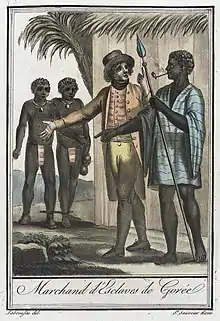
In the Senegambia region, between 1300 and 1900, close to one-third of the population was enslaved.[159] In early Islamic states of the western Sahel, including Ghana (750–1076), Mali (1235–1645), Segou (1712–1861), and Songhai (1275–1591), about a third of the population were enslaved.[160] In Sierra Leone in the 19th century about half of the population consisted of enslaved people.[161] Among the Vai people, during the 19th century, three quarters of people were slaves.[32] In the 19th century at least half the population was enslaved among the Duala of the Cameroon and other peoples of the lower Niger, the Kongo, and the Kasanje kingdom and Chokwe of Angola.[162] Among the Ashanti and Yoruba a third of the population consisted of enslaved people as well as the Bono.[163] The population of the Kanem (1600–1800) was about one-third enslaved.[164] It was perhaps 40% in Bornu (1580–1890). Between 1750 and 1900 from one- to two-thirds of the entire population of the Fulani jihad states consisted of enslaved people.[165] The population of the Sokoto caliphate formed by Hausas in the northern Nigeria and Cameroon was half-enslaved in the 19th century.[166] Slavery was widespread among Tuareg peoples and lasted until at least 1975.[167] Among the Adrar 15 percent of people were enslaved, and 75 percent of the Gurma were enslaved.[168]
When British rule was first imposed on the Sokoto Caliphate and the surrounding areas in northern Nigeria at the turn of the 20th century, approximately 2 million to 2.5 million people there were enslaved.[169] Slavery in northern Nigeria was finally outlawed in 1936.[170]
African Great Lakes
With sea trade from the eastern African Great Lakes region to Persia, China, and India during the first millennium AD, slaves are mentioned as a commodity of secondary importance to gold and ivory.[171] When mentioned, the slave trade appears to be of a small-scale and mostly involves slave raiding of women and children along the islands of Kilwa Kisiwani, Madagascar, and Pemba.[172] In places such as Uganda, the experience for women in slavery was different than that of customary slavery practices at the time. The roles assumed were based on gender and position within the society [173] First one must make the distinction in Ugandan slavery of peasants and slaves. Researchers Shane Doyle and Henri Médard assert the distinction with the following:
"Peasants were rewarded for valour in battle by the present of slaves by the lord or chief for whom they had fought. They could be given slaves by relatives who had been promoted to the rank of chiefs, and they could inherit slaves from their fathers.[174] There were the abanyage (those pillaged or stolen in war) as well as the abagule (those bought).[175] All these came under the category of abenvumu or true slaves, that is to say people not free in any sense.[176][177] In a superior position were the young Ganda given by their maternal uncles into slavery (or pawnship), usually in lieu of debts... Besides such slaves both chiefs and king were served by sons of well to do men who wanted to please them and attract favour for themselves or their children.[178][179] These were the abasige and formed a big addition to a noble household.... All these different classes of dependents in a household were classed as Medard & Doyle abaddu (male servants) or abazana (female servants) whether they were slave or free-born.(175)"[180]
In the Great Lakes region of Africa (around present-day Uganda), linguistic evidence shows the existence of slavery through war capture, trade, and pawning going back hundreds of years; however, these forms, particularly pawning, appear to have increased significantly in the 18th and 19th centuries.[181][182] These slaves were considered to be more trustworthy than those from the Gold Coast. They were regarded with more prestige because of the training they responded to.[183]
The language for slaves in the Great Lakes region varied.[184] This region of water made it easy for capture of slaves and transport. Captive, refugee, slave, peasant were all used in order to describe those in the trade.[185] The distinction was made by where and for what purpose they would be utilized for. Methods like pillage, plunder, and capture were all semantics common in this region to depict the trade.[186]
Historians Campbell and Alpers argue that there were a host of different categories of labor in Southeast Africa and that the distinction between slave and free individuals was not particularly relevant in most societies.[187][188] However, with increasing international trade in the 18th and 19th century, Southeast Africa began to be involved significantly in the Atlantic slave trade; for example, with the king of Kilwa island signing a treaty with a French merchant in 1776 for the delivery of 1,000 slaves per year.[189][190]
At about the same time, merchants from Oman, India, and Southeast Africa began establishing plantations along the coasts and on the islands,[191] To provide workers on these plantations, slave raiding and slave holding became increasingly important in the region and slave traders (most notably Tippu Tip) became prominent in the political environment of the region.[192][190] The Southeast African trade reached its height in the early decades of the 1800s with up to 30,000 slaves sold per year. However, slavery never became a significant part of the domestic economies except in Sultanate of Zanzibar where plantations and agricultural slavery were maintained.[157] Author and historian Timothy Insoll wrote: "Figures record the exporting of 718,000 slaves from the Swahili coast during the 19th century, and the retention of 769,000 on the coast."[193][194] At various times, between 65 and 90 percent of Zanzibar was enslaved. Along the Kenya coast, 90 percent of the population was enslaved, while half of Madagascar's population was enslaved.[195][196]
Transformations of slavery in Africa
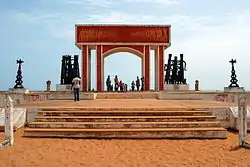
Slave relationships in Africa have been transformed through four large-scale processes: the trans-Saharan slave trade, the Indian Ocean slave trade the Atlantic slave trade, and the slave emancipation policies and movements in the 19th and 20th centuries.[197] Each of these processes significantly changed the forms, level, and economics of slavery in Africa.[4]
Slave practices in Africa were used during different periods to justify specific forms of European engagement with the peoples of Africa.[198] Eighteenth century writers in Europe claimed that slavery in Africa was quite brutal in order to justify the Atlantic slave trade.[199] Later writers used similar arguments to justify intervention and eventual colonization by European powers to end slavery in Africa.[200]
Africans knew of the harsh slavery that awaited slaves in the New World.[201] Many elite Africans visited Europe on slave ships following the prevailing winds through the New World.[52] One example of this occurred when Antonio Manuel, Kongo’s ambassador to the Vatican, went to Europe in 1604, stopping first in Bahia, Brazil, where he arranged to free a countryman who had been wrongfully enslaved.[202] African monarchs also sent their children along these same slave routes to be educated in Europe, and thousands of former slaves eventually returned to settle Liberia and Sierra Leone.[203][53]
Trans-Saharan and Indian Ocean trade
Early records of trans-Saharan slave trade come from ancient Greek historian Herodotus in the 5th century BC.[204][205] The Garamentes were by Herodotus recorded to engage in the trans-Saharan slave trade were they enslaved cave-dwelling Ethiopians or Troglodytae. The Garamentes relied heavily on labour from sub-Saharan Africa, in the shape of slaves,[206] they used slaves in their own communities to construct and maintain underground irrigation systems known to Berbers as foggara.[207]
In the early Roman Empire, the city of Lepcis established a slave market to buy and sell slaves from the African interior.[204] The empire imposed customs tax on the trade of slaves.[204] In 5th century AD, Roman Carthage was trading in black slaves brought across the Sahara.[205] Black slaves seem to have been valued in the Mediterranean as household slaves for their exotic appearance.[205] Some historians argue that the scale of slave trade in this period may have been higher than medieval times due to high demand of slaves in the Roman Empire.[205]
Slave trading in the Indian Ocean goes back to 2500 BCE.[208] Ancient Babylonians, Egyptians, Greeks, Indians and Persians all traded slaves on small scale across the Indian Ocean (and sometimes the Red Sea).[209] Slave trading in the Red Sea around the time of Alexander the Great is described by Agatharchides.[209] Strabo's Geographica (completed after 23 CE) mentions Greeks from Egypt trading slaves at the port of Adulis and other ports on the Somali coast.[210] Pliny the Elder's Natural History (published in 77 CE) also describes Indian Ocean slave trading.[209] In the 1st century CE, Periplus of the Erythraean Sea advised of slave trading opportunities in the region, particularly in the trading of "beautiful girls for concubinage."[209] According to this manual, slaves were exported from Omana (likely near modern-day Oman) and Kanê to the west coast of India.[209] The ancient Indian Ocean slave trade was enabled by building boats capable of carrying large numbers of human beings in the Persian Gulf using wood imported from India. These shipbuilding activities go back to Babylonian and Achaemenid times.[211]
After the involvement of the Byzantine Empire and Sassanian Empire in slave trading in the 1st century, it became a major enterprise.[209] Cosmas Indicopleustes wrote in his Christian Topography (550 CE) that slaves captured in Ethiopia would be imported into Byzantine Egypt via the Red Sea.[210] He also mentioned the import of eunuchs by the Byzantines from Mesopotamia and India.[210] After the 1st century, the export of black Africans became a "constant factor".[211] Under the Sassanians, Indian Ocean trade was used not just to transport slaves, but also scholars and merchants.[209]
The enslavement of Africans for eastern markets started before 7th century but remained at low levels until 1750.[212] The trade volume peaked around 1850 but would largely have ended around 1900.[212] Muslim participation in the slave trade started in the eighth and ninth centuries AD, beginning with small-scale movement of people largely from the eastern Great Lakes region and the Sahel.[213] Islamic law allowed slavery, but prohibited slavery involving other pre-existing Muslims; as a result, the main target for slavery were the people who lived in the frontier areas of Islam in Africa.[21] The trade of slaves across the Sahara and across the Indian Ocean also has a long history beginning with the control of sea routes by Afro-Arab traders in the ninth century.[214] It is estimated that, at that time, a few thousand enslaved people were taken each year from the Red Sea and Indian Ocean coast.[215] They were sold throughout the Middle East.[216][217] This trade accelerated as superior ships led to more trade and greater demand for labour on plantations in the region.[218] Eventually, tens of thousands per year were being taken.[219] On the Swahili Coast, the Afro-Arab slavers captured Bantu peoples from the interior and brought them to the littoral.[220][221] There, the slaves gradually assimilated in the rural areas, particularly on the Unguja and Pemba islands.[220]
This changed the slave relationships by creating new forms of employment by slaves (as eunuchs to guard harems, and in military units) and creating conditions for freedom (namely conversion—although it would only free a slave's children).[4][35] Although the level of the trade remained relatively small, the size of total slaves traded grew to a large number over the multiple centuries of its existence.[4] Because of its small and gradual nature, the impact on slavery practices in communities that did not convert to Islam was relatively small.[4] However, in the 1800s, the slave trade from Africa to the Islamic countries picked up significantly. When the European slave trade ended around the 1850s,[222] the slave trade to the east picked up significantly only to be ended with European colonization of Africa around 1900.[157] Between 1500 and 1900, up to 17 million Africans slaves were transported by Muslim traders to the coast of the Indian Ocean, the Middle East, and North Africa.[223]
In 1814, Swiss explorer Johann Burckhardt wrote of his travels in Egypt and Nubia, where he saw the practice of slave trading: "I frequently witnessed scenes of the most shameless indecency, which the traders, who were the principal actors, only laughed at. I may venture to state, that very few female slaves who have passed their tenth year, reach Egypt or Arabia in a state of virginity."[224]

David Livingstone while talking about the slave trade in East Africa in his journals:
To overdraw its evil is a simple impossibility.[225]:442
Livingstone wrote about a group of slaves forced to march by Arab slave traders in the African Great Lakes region when he was travelling there in 1866:[226]
19th June 1866 - We passed a woman tied by the neck to a tree and dead, the people of the country explained that she had bene unable to keep up with the other slaves in a gang, and her master had determined that she should not become anyone's property if she recovered.[225]:56
26th June 1866 – ... We passed a slave woman shot or stabbed through the body and lying on the path: a group of mon stood about a hundred yards off on one side, and another of the women on the other side, looking on; they said an Arab who passed early that morning had done it in anger at losing the price he had given for her, because she was unable to walk any longer.
27th June 1866 – To-day we came upon a man dead from starvation, as he was very thin. One of our men wandered and found many slaves with slave-sticks on, abandoned by their masters from want of food; they were too weak to be able to speak or say where they had come from; some were quite young.[225]:62
Zanzibar was once East Africa's main slave-trading port, and under Omani Arabs in the 19th century as many as 50,000 slaves were passing through the city each year.[227]
European slave trade in the Indian Ocean began when Portugal established Estado da Índia in the early 16th century. From then until the 1830s, c. 200 slaves were exported from Mozambique annually and similar figures has been estimated for slaves brought from Asia to the Philippines during the Iberian Union (1580–1640).[228]
The establishment of the Dutch East India Company in the early 17th century lead to a quick increase in volume of the slave trade in the region; there were perhaps up to 500,000 slaves in various Dutch colonies during the 17th and 18th centuries in the Indian Ocean. For example, some 4000 African slaves were used to build the Colombo fortress in Dutch Ceylon. Bali and neighbouring islands supplied regional networks with c. 100,000–150,000 slaves 1620–1830. Indian and Chinese slave traders supplied Dutch Indonesia with perhaps 250,000 slaves during 17th and 18th centuries.[228]
The East India Company (EIC) was established during the same period and in 1622 one of its ships carried slaves from the Coromandel Coast to Dutch East Indies. The EIC mostly traded in African slaves but also some Asian slaves purchased from Indian, Indonesian and Chinese slave traders. The French established colonies on the islands of Réunion and Mauritius in 1721; by 1735 some 7,200 slaves populated the Mascarene Islands, a number which had reached 133,000 in 1807. The British captured the islands in 1810, however, and because the British had prohibited the slave trade in 1807 a system of clandestine slave trade developed to bring slaves to French planters on the islands; in all 336,000–388,000 slaves were exported to the Mascarane Islands from 1670 until 1848.[228]
In all, Europeans traders exported 567,900–733,200 slaves within the Indian Ocean between 1500 and 1850 and almost that same amount were exported from the Indian Ocean to the Americas during the same period. Slave trade in the Indian Ocean was, nevertheless, very limited compared to c. 12,000,000 slaves exported across the Atlantic.[228]
Atlantic slave trade
.jpg.webp)
The Atlantic slave trade or transatlantic slave trade took place across the Atlantic Ocean from the 15th through to the 19th centuries.[229] According to Patrick Manning, the Atlantic slave trade was significant in transforming Africans from a minority of the global population of slaves in 1600 into the overwhelming majority by 1800 and by 1850 the number of African slaves within Africa exceeded those in the Americas.[230]
The slave trade was transformed from a marginal aspect of the economies into the largest sector in a relatively short span.[231] In addition, agricultural plantations increased significantly and became a key aspect in many societies.[232][4] Economic urban centers that served as the root of main trade routes shifted towards the West coast.[233] At the same time, many African communities relocated far away from slave trade routes, often protecting themselves from the Atlantic slave trade but hindering economic and technological development at the same time.[234]
In many African societies traditional lineage slavery became more like chattel slavery due to an increased work demand.[235] This resulted in a general decrease in quality of life, working conditions, and status of slaves in West African societies.[236] Assimilative slavery was increasingly replaced with chattel slavery.[237] Assimilitave slavery in Africa often allowed eventual freedom and also significant cultural, social, and/or economic influence.[238] Slaves were often treated as part of their owner's family, rather than simply property.[235]
The distribution of gender among enslaved peoples under traditional lineage slavery saw women as more desirable slaves due to demands for domestic labor and for reproductive reasons.[235] Male slaves were used for more physical agricultural labor,[239] but as more enslaved men were taken to the West Coast and across the Atlantic to the New World, female slaves were increasingly used for physical and agricultural labour and polygyny also increased.[240] Chattel slavery in America was highly demanding because of the physical nature of plantation work and this was the most common destination for male slaves in the New World.[235]
It has been argued that a decrease in able-bodied people as a result of the Atlantic slave trade limited many societies ability to cultivate land and develop.[241] Many scholars argue that the transatlantic slave trade, left Africa underdeveloped, demographically unbalanced, and vulnerable to future European colonization.[234]
The first Europeans to arrive on the coast of Guinea were the Portuguese; the first European to actually buy enslaved Africans in the region of Guinea was Antão Gonçalves, a Portuguese explorer in 1441 AD.[242] Originally interested in trading mainly for gold and spices, they set up colonies on the uninhabited islands of São Tomé.[243] In the 16th century the Portuguese settlers found that these volcanic islands were ideal for growing sugar.[244] Sugar growing is a labour-intensive undertaking and Portuguese settlers were difficult to attract due to the heat, lack of infrastructure, and hard life.[245] To cultivate the sugar the Portuguese turned to large numbers of enslaved Africans. Elmina Castle on the Gold Coast, originally built by African labour for the Portuguese in 1482 to control the gold trade, became an important depot for slaves that were to be transported to the New World.[246]
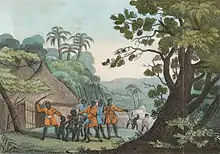
The Spanish were the first Europeans to use enslaved Africans in America on islands such as Cuba and Hispaniola,[247] where the alarming death rate in the native population had spurred the first royal laws protecting the native population (Laws of Burgos, 1512–13).[248] The first enslaved Africans arrived in Hispaniola in 1501 soon after the Papal Bull of 1493 gave almost all of the New World to Spain.[249]
In Igboland, for example, the Aro oracle (the Igbo religious authority) began condemning more people to slavery due to small infractions that previously probably wouldn't have been punishable by slavery, thus increasing the number of enslaved men available for purchase.[235]
The Atlantic slave trade peaked in the late 18th century, when the largest number of people were bought or captured from West Africa and taken to the Americas.[250] The increase of demand for slaves due to the expansion of European colonial powers to the New World made the slave trade much more lucrative to the West African powers, leading to the establishment of a number of actual West African empires thriving on slave trade.[251] These included the Bono State, Oyo empire (Yoruba), Kong Empire, Imamate of Futa Jallon, Imamate of Futa Toro, Kingdom of Koya, Kingdom of Khasso, Kingdom of Kaabu, Fante Confederacy, Ashanti Confederacy, and the kingdom of Dahomey.[252] These kingdoms relied on a militaristic culture of constant warfare to generate the great numbers of human captives required for trade with the Europeans.[4][253] It is documented in the Slave Trade Debates of England in the early 19th century: "All the old writers concur in stating not only that wars are entered into for the sole purpose of making slaves, but that they are fomented by Europeans, with a view to that object."[254] The gradual abolition of slavery in European colonial empires during the 19th century again led to the decline and collapse of these African empires.[255] When European powers began to stop the Atlantic slave trade, this caused a further change in that large holders of slaves in Africa began to exploit enslaved people on plantations and other agricultural products.[256]
Abolition
The final major transformation of slave relationships came with the inconsistent emancipation efforts starting in the mid-19th century.[257] As European authorities began to take over large parts of inland Africa starting in the 1870s, the colonial policies were often confusing on the issue.[258] For example, even when slavery was deemed illegal, colonial authorities would return escaped slaves to their masters.[259][4] Slavery persisted in some countries under colonial rule, and in some instances it was not until independence that slavery practices were significantly transformed.[260][261] Anti-colonial struggles in Africa often brought slaves and former slaves together with masters and former masters to fight for independence;[262] however, this cooperation was short-lived and following independence political parties would often form based upon the stratifications of slaves and masters.[263][157]
In some parts of Africa, slavery and slavery-like practices continue to this day, particularly the illegal trafficking of women and children.[264][265] The problem has proven to be difficult for governments and civil society to eliminate.[266][267]
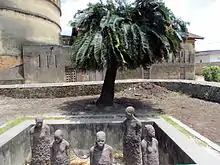
Efforts by Europeans against slavery and the slave trade began in the late 18th century and had a large impact on slavery in Africa.[268] Portugal was the first country in the continent to abolish slavery in metropolitan Portugal and Portuguese India by a bill issued on 12 February 1761, but this did not affect their colonies in Brazil and Africa.[269] France abolished slavery in 1794. However, slavery was again allowed by Napoleon in 1802 and not abolished for good until 1848.[270] In 1803, Denmark-Norway became the first country from Europe to implement a ban on the slave trade.[271] Slavery itself was not banned until 1848.[272] Britain followed in 1807 with the passage of the Abolition of the Slave Trade Act by Parliament.[273] This law allowed stiff fines, increasing with the number of slaves transported, for captains of slave ships.[274] Britain followed this with the Slavery Abolition Act 1833 which freed all slaves in the British Empire.[275] British pressure on other countries resulted in them agreeing to end the slave trade from Africa.[276] For example, the 1820 U.S. Law on Slave Trade made slave trading piracy, punishable by death.[277] In addition, the Ottoman Empire abolished slave trade from Africa in 1847 under British pressure.[278]
By 1850, the year that the last major Atlantic slave trade participant (Brazil) passed the Eusébio de Queirós Law banning the slave trade,[279] the slave trades had been significantly slowed and in general only illegal trade went on.[280] Brazil continued the practice of slavery and was a major source for illegal trade until about 1870 and the abolition of slavery became permanent in 1888 when Princess Isabel of Brazil and Minister Rodrigo Silva (son-in-law of senator Eusebio de Queiroz) banned the practice.[157] The British took an active approach to stopping the illegal Atlantic slave trade during this period.[281] The West Africa Squadron was credited with capturing 1,600 slave ships between 1808 and 1860, and freeing 150,000 Africans who were aboard these ships.[282] Action was also taken against African leaders who refused to agree to British treaties to outlaw the trade, for example against ‘the usurping King of Lagos’, deposed in 1851.[283] Anti-slavery treaties were signed with over 50 African rulers.
According to Patrick Manning, internal slavery was most important to Africa in the second half of the 19th century, stating "if there is any time when one can speak of African societies being organized around a slave mode production, [1850–1900] was it".[285] The abolition of the Atlantic slave trade resulted in the economies of African states dependent on the trade being reorganized towards domestic plantation slavery and legitimate commerce worked by slave labor.[286] Slavery before this period was generally domestic.[157][10]
The continuing anti-slavery movement in Europe became an excuse and a casus belli for the European conquest and colonization of much of the African continent.[200] It was the central theme of the Brussels Anti-Slavery Conference 1889-90.[287] In the late 19th century, the Scramble for Africa saw the continent rapidly divided between imperialistic European powers, and an early but secondary focus of all colonial regimes was the suppression of slavery and the slave trade.[288] Seymour Drescher argues that European interests in abolition were primarily motivated by economic and imperial goals.[289] Despite slavery often being a justification behind conquest, colonial regimes often ignored slavery or allowed slavery practices to continue.[290][291] This was because the colonial state depended on the cooperation of indigenous political and economic structures which were heavily involved in slavery.[292] As a result, early colonial policies usually sought to end slave trading while regulating existing slave practices and weakening the power of slave maaters.[293][138] Furthermore, the early colonial states had weak effective control over their territories, which precluded efforts to widespread abolition. Abolition attempts became more concrete later during the colonial period.[294][138]
There were many causes for the decline and abolition of slavery in Africa during the colonial period including colonial abolition policies, various economic changes, and slave resistance.[295] The economic changes during the colonial period, including the rise of wage labor and cash crops, hastened the decline of slavery by offering new economic opportunities to slaves.[296] The abolition of slave raiding and the end of wars between African states drastically reduced the supply of slaves.[297] Slaves would take advantage of early colonial laws that nominally abolished slavery and would migrate away from their masters although these laws often were intended to regulate slavery more than actually abolish it.[298] This migration led to more concrete abolition efforts by colonial governments.[138][299][4]
Following conquest and abolition by the French, over a million slaves in French West Africa fled from their masters to earlier homes between 1906 and 1911.[300] In Madagascar over 500,000 slaves were freed following French abolition in 1896.[301] In response to this pressure, Ethiopia officially abolished slavery in 1932, Sokoto Caliphate abolished slavery in 1900, and the rest of the Sahel in 1911.[302] Colonial nations were mostly successful in this aim, though slavery is still very active in Africa even though it has gradually moved to a wage economy.[303] Independent nations attempting to westernize or impress Europe sometimes cultivated an image of slavery suppression, even as they, in the case of Egypt, hired European soldiers like Samuel White Baker's expedition up the Nile.[304] Slavery has never been eradicated in Africa, and it commonly appears in African states, such as Chad, Ethiopia, Mali, Niger, and Sudan, in places where law and order have collapsed.[305]
Although outlawed in all countries today, slavery is practiced in secret in many parts of the world.[306] There are an estimated 30 million victims of slavery worldwide.[307] In Mauritania alone, up to 600,000 men, women and children, or 20% of the population, are enslaved, many of them used as bonded labour.[308][309] Slavery in Mauritania was finally criminalized in August 2007.[310] During the Second Sudanese Civil War people were taken into slavery; estimates of abductions range from 14,000 to 200,000.[311] In Niger, where the practice of slavery was outlawed in 2003, a study found that almost 8% of the population are still slaves.[312][313]
Effects
Demographics
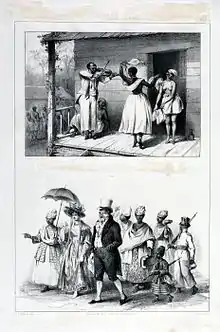
Slavery and the slave trades had a significant impact on the size of the population and the gender distribution throughout much of Africa. The precise impact of these demographic shifts has been an issue of significant debate.[314] The Atlantic slave trade took 70,000 people, primarily from the west coast of Africa, per year at its peak in the mid-1700s.[157] The trans-Saharan slave trade involved the capture of peoples from the continental interior, who were then shipped overseas through ports on the Red Sea and elsewhere.[315] It peaked at 10,000 people bartered per year in the 1600s.[157] According to Patrick Manning, there was a consistent population decrease in large parts of Sub-Saharan Africa as a result of these slave trades.[316] This population decline throughout West Africa from 1650 until 1850 was exacerbated by the preference of slave traders for male slaves.[317] It is important to note that this preference only existed in the transatlantic slave trade. More female slaves than male were traded across the continent of Africa.[109][157] In eastern Africa, the slave trade was multi-directional and changed over time.[197] To meet the demand for menial labor, Zanj slaves captured from the southern interior were sold through ports on the northern seaboard in cumulatively large numbers over the centuries to customers in the Nile Valley, Horn of Africa, Arabian Peninsula, Persian Gulf, India, Far East and the Indian Ocean islands.[315]
Extent of slavery
The extent of slavery within Africa and the trade in slaves to other regions is not known precisely.[318] Although the Atlantic slave trade has been best studied, estimates range from 8 million people to 20 million.[319] The Trans-Atlantic Slave Trade Database estimates that the Atlantic slave trade took around 12.8 million people between 1450 and 1900.[4][320] The slave trade across the Sahara and Red Sea from the Sahara, the Horn of Africa, and East Africa, has been estimated at 6.2 million people between 600 and 1600.[321][4] Although the rate decreased from East Africa in the 1700s, it increased in the 1800s and is estimated at 1.65 million for that century.[322][4]
Estimates by Patrick Manning are that about 12 million slaves entered the Atlantic trade between the 16th and 19th century, but about 1.5 million died on board ship.[323] About 10.5 million slaves arrived in the Americas.[323] Besides the slaves who died on the Middle Passage, more Africans likely died during the slave raids in Africa and forced marches to ports.[324] Manning estimates that 4 million died inside Africa after capture, and many more died young.[323] Manning's estimate covers the 12 million who were originally destined for the Atlantic, as well as the 6 million destined for Asian slave markets and the 8 million destined for African markets.[323]
Debate about demographic effect
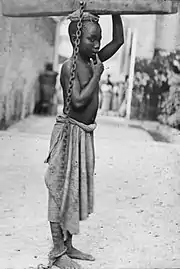
The demographic effects of the slave trade are some of the most controversial and debated issues.[325] Walter Rodney argued that the export of so many people had been a demographic disaster and had left Africa permanently disadvantaged when compared to other parts of the world, and that this largely explains that continent's continued poverty.[326] He presents numbers that show that Africa's population stagnated during this period, while that of Europe and Asia grew dramatically. According to Rodney all other areas of the economy were disrupted by the slave trade as the top merchants abandoned traditional industries to pursue slaving and the lower levels of the population were disrupted by the slaving itself.[327]
Others have challenged this view. J. D. Fage compared the number effect on the continent as a whole.[328] David Eltis has compared the numbers to the rate of emigration from Europe during this period.[329] In the 19th century alone over 50 million people left Europe for the Americas, a far higher rate than were ever taken from Africa.[330]
Others in turn challenged that view. Joseph E. Inikori argues the history of the region shows that the effects were still quite deleterious.[331] He argues that the African economic model of the period was very different from the European, and could not sustain such population losses.[332] Population reductions in certain areas also led to widespread problems.[333] Inikori also notes that after the suppression of the slave trade Africa's population almost immediately began to rapidly increase, even prior to the introduction of modern medicines.[334]
Effect on the economy of Africa


There is a longstanding debate among analysts and scholars about the destructive impacts of the slave trades.[56] It is often claimed that the slave trade undermined local economies and political stability as villages' vital labour forces were shipped overseas as slave raids and civil wars became commonplace.[335] With the rise of a large commercial slave trade, driven by European needs, enslaving your enemy became less a consequence of war, and more and more a reason to go to war.[336] The slave trade was claimed to have impeded the formation of larger ethnic groups, causing ethnic factionalism and weakening the formation for stable political structures in many places.[337] It also is claimed to have reduced the mental health and social development of African people.[338]
In contrast to these arguments, J. D. Fage asserts that slavery did not have a wholly disastrous effect on the societies of Africa.[339] Slaves were an expensive commodity, and traders received a great deal in exchange for each enslaved person.[340] At the peak of the slave trade hundreds of thousands of muskets, vast quantities of cloth, gunpowder, and metals were being shipped to Guinea.[341] Most of this money was spent on British-made firearms (of very poor quality) and industrial-grade alcohol.[342] Trade with Europe at the peak of the slave trade—which also included significant exports of gold and ivory—was some 3.5 million pounds Sterling per year.[343] By contrast, the trade of the United Kingdom, the economic superpower of the time, was about 14 million pounds per year over this same period of the late 18th century.[344] As Patrick Manning has pointed out, the vast majority of items traded for slaves were common rather than luxury goods.[345] Textiles, iron ore, currency, and salt were some of the most important commodities imported as a result of the slave trade, and these goods were spread within the entire society raising the general standard of living.[346][56]
Although debated, it is argued that the Atlantic slave trade devastated the African economy.[347] In 19th century Yoruba Land, economic activity was described to be at its lowest ever while life and property were being taken daily, and normal living was in jeopardy because of the fear of being kidnapped.[348] (Onwumah, Imhonopi, Adetunde,2019)
Effects on Europe's economy
Karl Marx in his economic history of capitalism, Das Kapital, claimed that "...the turning of Africa into a warren for the commercial hunting of black-skins [that is, the slave trade], signalled the rosy dawn of the era of capitalist production.[349] "He argued that the slave trade was part of what he termed the "primitive accumulation"[350] of European capital, the non-capitalist accumulation of wealth that preceded and created the financial conditions for Britain's industrialisation and the advent of the capitalist mode of production.[351][352]
Eric Williams has written about the contribution of Africans on the basis of profits from the slave trade and slavery, arguing that the employment of those profits were used to help finance Britain's industrialisation.[353] He argues that the enslavement of Africans was an essential element to the Industrial Revolution, and that European wealth was, in part, a result of slavery, but that by the time of its abolition it had lost its profitability and it was in Britain's economic interest to ban it.[354] Joseph Inikori has written that the British slave trade was more profitable than the critics of Williams believe.[355] Other researchers and historians have strongly contested what has come to be referred to as the "Williams thesis" in academia: David Richardson has concluded that the profits from the slave trade amounted to less than 1% of domestic investment in Britain,[356] and economic historian Stanley Engerman finds that even without subtracting the associated costs of the slave trade (e.g., shipping costs, slave mortality, mortality of whites in Africa, defense costs)[357] or reinvestment of profits back into the slave trade, the total profits from the slave trade and of West Indian plantations amounted to less than 5% of the British economy during any year of the Industrial Revolution.[358] Historian Richard Pares, in an article written before Williams’ book, dismisses the influence of wealth generated from the West Indian plantations upon the financing of the Industrial Revolution, stating that whatever substantial flow of investment from West Indian profits into industry there was occurred after emancipation,[359] not before.[360] Findlay and O'Rourke noted that the figures presented by O'Brien (1982) to back his claim that "the periphery was peripheral" suggest the opposite, with profits from the periphery 1784–1786 being £5.66 million when there was £10.30 million total gross investment in the British economy and similar proportions for 1824–1826.[361] They note that dismissing the profits of the enslavement of human beings from significance because it was a "small share of national income",[362] could be used to argue that there was no industrial revolution, since modern industry provided only a small share of national income and that it is a mistake to assume that small size is the same as small significance.[363] Findlay and O'Rourke also note that the share of American export commodities produced by enslaved human beings, rose from 54% between 1501 and 1550 to 82.5% between 1761 and 1780.[364]
Seymour Drescher and Robert Anstey argue the slave trade remained profitable until the end,[365] because of innovations in agriculture, and that moralistic reform, not economic incentive, was primarily responsible for abolition.[366]
A similar debate has taken place about other European nations.[367] The French slave trade, it is argued, was more profitable than alternative domestic investments, and probably encouraged capital accumulation before the Industrial Revolution and Napoleonic Wars.[368]
Legacy of racism
Maulana Karenga states the effects of the Atlantic slave trade in African captives:[369] "[T]he morally monstrous destruction of human possibility involved redefining African humanity to the world, poisoning past, present and future relations with others who only know us through this stereotyping and thus damaging the truly human relations among people of today".[370] He says that it constituted the destruction of culture, language, religion and human possibility.[371]
See also
- Cudjoe Lewis
- Atlantic slave trade
- Blockade of Africa
- Slavery in modern Africa
- Anti-Slavery operations of the United States Navy
- Barbary pirates
- Christianity and slavery
- Islamic views on slavery
- Slavery in Mauritania
- Slavery in Sudan
- Unfree labor
- Maafa
- Tippu Tip
- Abolitionism
- History of slavery
- History of slavery in the United States
- James Riley (Captain)
- Slave ship
- African Diaspora
- Slavery
- Asiento de Negros
References
- Jennings, Justin (2010), "But Were They Really Global Cultures?", Globalizations and the Ancient World, Cambridge: Cambridge University Press, pp. 121–142, doi:10.1017/cbo9780511778445.007, ISBN 978-0-511-77844-5
- "The slave trade in the eighteenth century", Senegambia and the Atlantic Slave Trade, Cambridge University Press, pp. 61–80, 13 December 1997, doi:10.1017/cbo9780511584084.009, ISBN 978-0-521-59226-0
- "The Atlantic Slave Trade in the Century of Abolition", The Atlantic Slave Trade from West Central Africa, 1780–1867, Cambridge University Press, pp. 16–37, 26 June 2017, doi:10.1017/9781316771501.003, ISBN 978-1-316-77150-1
- Lovejoy, Paul E. (2012). Transformations of Slavery: A History of Slavery in Africa. London: Cambridge University Press.
- Foner, Eric (2012). Give Me Liberty: An American History. New York: W. W. Norton & Company. p. 18.
- Moore, Sean D. (28 February 2019), "See Benezet's Account of Africa Throughout", Slavery and the Making of Early American Libraries, Oxford University Press, pp. 166–200, doi:10.1093/oso/9780198836377.003.0005, ISBN 978-0-19-883637-7
- Lovejoy, Paul E. (2011), "Slavery and "Legitimate Trade" on the West African Coast", Transformations in Slavery, Cambridge: Cambridge University Press, pp. 160–184, doi:10.1017/cbo9781139014946.012, ISBN 978-1-139-01494-6
- Fernyhough, Timothy (1988). "Slavery and the Slave Trade in Southern Ethiopia in the 19th Century". Slavery & Abolition. 9 (3): 103–130. doi:10.1080/01440398808574965. ISSN 0144-039X.
- Austin, Gareth (17 August 1995), "Between abolition and Jihad: the Asante response to the ending of the Atlantic slave trade, 1807–1896", From Slave Trade to 'Legitimate' Commerce, Cambridge University Press, pp. 93–118, doi:10.1017/cbo9780511523861.005, ISBN 978-0-521-48127-4
- David Eltis; Stanley L. Engerman; Seymour Drescher; David Richardson, eds. (2017). "Slavery in Africa, 1804-1936". New York: Cambridge University Press. Missing or empty
|title=(help) - Stilwell, Sean (2013), "Slavery in African History", Slavery and Slaving in African History, Cambridge: Cambridge University Press, pp. 29–59, doi:10.1017/cbo9781139034999.003, ISBN 978-1-139-03499-9
- "Slavery, Slave Trade". doi:10.1163/1878-9781_ejiw_com_000524. Cite journal requires
|journal=(help) - Painter, Nell Irvin; Berlin, Ira (2000). "Many Thousands Gone: The First Two Centuries of Slavery in North America". African American Review. 34 (3): 515. doi:10.2307/2901390. ISSN 1062-4783. JSTOR 2901390.
- Noel King (ed.), Ibn Battuta in Black Africa, Princeton 2005, p. 54.
- Fage, J.D. (1969). "Slavery and the Slave Trade in the Context of West African History". The Journal of African History. 10 (3): 393–404. doi:10.1017/s0021853700036343.
- Rodney, Walter (1966). "African Slavery and Other Forms of Social Oppression on the Upper Guinea Coast in the Context of the Atlantic Slave-Trade". The Journal of African History. 7 (3): 431–443. doi:10.1017/s0021853700006514. JSTOR 180112.
- McMahon, Elisabeth (2013), "Mitigating Vulnerability through Kinship", Slavery and Emancipation in Islamic East Africa, Cambridge: Cambridge University Press, pp. 193–230, doi:10.1017/cbo9781139198837.008, ISBN 978-1-139-19883-7
- Snell, Daniel C. (2011). "Slavery in the Ancient Near East". In Keith Bradley and Paul Cartledge (ed.). The Cambridge World History of Slavery. New York: Cambridge University Press. pp. 4–21.
- Gudmestad, Robert (26 January 2006). "Technology and the World the Slaves Made". History Compass. 4 (2): 373–383. doi:10.1111/j.1478-0542.2006.00313.x. ISSN 1478-0542.
- "Othering the Slave Owner", American Slavery, American Imperialism, Cambridge University Press, pp. 107–146, 31 August 2020, doi:10.1017/9781108663908.004, ISBN 978-1-108-66390-8
- Alexander, J. (2001). "Islam, Archaeology and Slavery in Africa". World Archaeology. 33 (1): 44–60. doi:10.1080/00438240126645. JSTOR 827888.
- Gaspar, D. B. (1998). More than chattel: black women and slavery in the Americas. Bloomington: Indiana University Press.
- "2. HOUSE SLAVES", The Slave Next Door, University of California Press, pp. 18–42, 31 December 2019, doi:10.1525/9780520948037-004, ISBN 978-0-520-94803-7
- Kett, Anna Vaughan (20 April 2017). "Without the Consumers of Slave Produce There Would Be No Slaves". University of Illinois Press. 1. doi:10.5406/illinois/9780252038266.003.0005.
- "Domestic Slavery: What Is It?". Anti-Slavery International.
- "Debt-Bondage and Serfdom", GREEK AND ROMAN SLAVERY, Abingdon, UK: Taylor & Francis, 1981, doi:10.4324/9780203358993_chapter_2, ISBN 978-0-203-37575-4
- "Epilogue: The Debtor and the Slave", Of Bondage, Philadelphia: University of Pennsylvania Press, pp. 145–148, 2013, doi:10.9783/9780812208221.145, ISBN 978-0-8122-0822-1
- Douglas, Mary (1964). "Matriliny and Pawnship in Central Africa". Africa. 34 (4): 301–313. doi:10.2307/1157471. ISSN 0001-9720. JSTOR 1157471.
- "Pledges. Delivery to Create a Future Pledge. Assignment of Debt to One Person and of Pledge to Another". Harvard Law Review. 35 (3): 345. 1922. doi:10.2307/1329636. ISSN 0017-811X. JSTOR 1329636.
- Lovejoy, Paul E. (7 March 2019), "Pawnship, slavery and freedom", Slavery in the Global Diaspora of Africa, New York, NY : Routledge, 2019. | Series: Global Africa; 12: Routledge, pp. 67–88, doi:10.4324/9781315163499-6, ISBN 978-1-315-16349-9CS1 maint: location (link)
- Horton, Khim (10 July 2019), "Common difficulties experienced by older people", Nursing Older People, Abingdon, Oxon; New York, NY: Routledge, 2019.: Routledge, pp. 52–72, doi:10.4324/9781315116129-6, ISBN 978-1-315-11612-9CS1 maint: location (link)
- Regnier, Denis (2015). "Clean people, unclean people: the essentialisation of 'slaves' among the southern Betsileo of Madagascar". Social Anthropology. 23 (2): 152–168. doi:10.1111/1469-8676.12107. ISSN 0964-0282.
- Paul E. Lovejoy and David Richardson (2001). "The Business of Slaving: Pawnship in Western Africa, c. 1600–1810". The Journal of African History. 42 (1): 67–89. doi:10.1017/S0021853700007787.
- Paul E. Lovejoy; Toyin Falola, eds. (2003). Pawnship, Slavery, and Colonialism in Africa. Trenton, NJ: Africa World Press.
- Johnson, Douglas H. (1989). "The Structure of a Legacy: Military Slavery in Northeast Africa". Ethnohistory. 36 (1): 72–88. doi:10.2307/482742. JSTOR 482742.
- Wylie, Kenneth C. (1969). "Innovation and Change in Mende Chieftaincy 1880–1896". The Journal of African History. 10 (2): 295–308. doi:10.1017/s0021853700009531. JSTOR 179516.
- Karg, H.; Drechsel, P., eds. (2018). Atlas of West African urban food systems: examples from Ghana and Burkina Faso. doi:10.5337/2018.224. hdl:10568/98421. ISBN 9789290908753.
- "Children 6 cm taller, 3 kg heavier than 30 years ago". Chinese Medical Journal. 120 (2): 173. 2007. doi:10.1097/00029330-200701020-00025. ISSN 0366-6999.
- Savage, Sharon (24 April 2018). "Faculty Opinions recommendation of Shorter telomere length in Europeans than in Africans due to polygenetic adaptation". doi:10.3410/f.726191338.793545190. Cite journal requires
|journal=(help) - Baten, Jörg (2011). "The biological standard of living in early nineteenth-century West Africa: new anthropometric evidence for northern Ghana and Burkina Faso". The Economic History Review.
- Drew University. Library. (1805–1917). [Quaker pamphlet collection]. OCLC 880321617.
- Morton, Fred (26 April 2017), "Slavery in the South African Interior During the 19th Century", Oxford Research Encyclopedia of African History, Oxford University Press, doi:10.1093/acrefore/9780190277734.013.77, ISBN 978-0-19-027773-4
- "Chapter 3. Societies with Slaves: Genoa, Venice, and the Mamluk Sultanate", That Most Precious Merchandise, Philadelphia: University of Pennsylvania Press, pp. 61–91, 31 December 2020, doi:10.9783/9780812296488-005, ISBN 978-0-8122-9648-8
- Milgrom, Jacob (1 January 2002), "Were the Firstborn Sacrificed to YHWH? To Molek? Popular Practice or Divine Demand?", Sacrifice in Religious Experience, BRILL, pp. 49–55, doi:10.1163/9789004379169_005, ISBN 978-90-04-37916-9
- "Figure 3. Schematic of experimental design". doi:10.7554/elife.11695.005. Cite journal requires
|journal=(help) - Parish, William L. (8 August 2019), "What Model Now?", Chinese Urban Reform, Routledge, pp. 3–16, doi:10.4324/9781315705736-2, ISBN 978-1-315-70573-6
- Clifford Williams (1988) However, The International Journal of African Historical Studies, Vol. 21, No. 3. (1988), pp. 433–441
- R. Rummel (1997)"Death by government". Transaction Publishers. p.63. ISBN 1-56000-927-6
- "Human Sacrifice". Encyclopædia Britannica. 26 August 2019.
- Peterson, Derek R.; Gavua, Kodzo; Rassool, Ciraj (2 March 2015). The Politics of Heritage in Africa. Cambridge University Press. ISBN 978-1-107-09485-7.
- Thornton, John (7 April 2005), "Imbangala", African American Studies Center, Oxford University Press, doi:10.1093/acref/9780195301731.013.41788, ISBN 978-0-19-530173-1
- "Freedom", The Atlantic World, Cambridge University Press, pp. 615–660, 16 February 2009, doi:10.1017/cbo9780511816604.018, ISBN 978-0-511-81660-4
- Henry Louis Gates Jr. "Ending the Slavery Blame-Game". Archived from the original on 23 April 2010. Retrieved 26 March 2012.
- "Harvard University, Department of African and African American Studies (AAAS)". doi:10.1163/_afco_asc_1693. Cite journal requires
|journal=(help) - "Reward Offered for Two Escaped Slaves (1745)", African American Studies Center, Oxford University Press, 30 September 2014, doi:10.1093/acref/9780195301731.013.34166, ISBN 978-0-19-530173-1
- Manning, Patrick (1983). "Contours of Slavery and Social Change in Africa". American Historical Review. 88 (4): 835–857. doi:10.2307/1874022. JSTOR 1874022. S2CID 155847068.
- Kwokeji, G. Ugo (2011). "Slavery in Non-Islamic West Africa, 1420–1820". In David Eltis and Stanley Engerman (ed.). The Cambridge World History of Slavery, Volume II. pp. 81–110.
- "Frames of War in New Kingdom Egypt", Body and Frames of War in New Kingdom Egypt, Harrassowitz, O, pp. 133–160, 11 November 2019, doi:10.2307/j.ctvsf1qpk.13, ISBN 978-3-447-19925-4
- Daniel C. Snell (2011). "Slavery in the ancient Near East". In K. Bradley, and P. Cartledge (ed.). The Cambridge World History of Slavery. 1. Cambridge University Press. pp. 16–17.
- Lowery, Allison (28 November 2019), "Ancient Egypt (3500 BC–30 BC)", Historical Wig Styling, Second edition. | New York : Routledge, 2019. | Series: The focal press costume topics series: Routledge, pp. 49–68, doi:10.4324/9780429422713-2, ISBN 978-0-429-42271-3CS1 maint: location (link)
- Dorothy J. Thompson (2011). "Slavery in the Hellenistic world". In K. Bradley, and P. Cartledge (ed.). The Cambridge World History of Slavery. 1. Cambridge University Press. p. 207.
For the slave-owners of Ptolemaic Egypt, Africa was an obvious source of slaves, and both land and sea routes from the south were well used
- "Burning of a Village in Africa, and Capture of its Inhabitants". Wesleyan Juvenile Offering. XVI: 12. February 1859. Retrieved 10 November 2015.
- Peltonen, Jaakkojuhani (13 March 2019), "Alexander in an empire of Romans, Greeks, and Jews", Alexander the Great in the Roman Empire, 150 BC to AD 600, Abingdon, Oxon ; New York, NY : Routledge, [2019] | “Reception of Alexander the Great.”: Routledge, pp. 29–91, doi:10.4324/9780429456046-2, ISBN 978-0-429-45604-6CS1 maint: location (link)
- Anstey, Roger (18 June 2019), "The Volume of the North American Slave-Carrying Trade from Africa 1761–1810", Slave Trade and Migration, Routledge, pp. 1–21, doi:10.4324/9781315057613-1, ISBN 978-1-315-05761-3
- Bertrand, Estelle (28 June 2019), "Imperialism and the Crisis of the Roman Republic: Dio's View on Late Republican Conquests (Books 36–40)", Cassius Dio and the Late Roman Republic, BRILL, pp. 19–35, doi:10.1163/9789004405158_003, ISBN 978-90-04-40515-8
- Keith Bradley (2011). "Slavery in the Roman Republic". In K. Bradley, and P. Cartledge (ed.). The Cambridge World History of Slavery. 1. Cambridge University Press. p. 246.
- Walter Scheidel (2011). "The Roman slave supply". In K. Bradley, and P. Cartledge (ed.). The Cambridge World History of Slavery. 1. Cambridge University Press. pp. 297–8.
While large-scale piracy undoubtedly contributed to the Roman slave supply, it is hard to assess the relative significance of this source. Later episodes of piracy show no clear connection with the slave trade, at least not until maritime raiders were said to carry off the inhabitants of coastal villages in Illyria and North Africa in the fifth century AD
- Fisher, Alan (1980). "Chattel Slavery in the Ottoman Empire". Slavery & Abolition. 1 (1): 25–45. doi:10.1080/01440398008574806. ISSN 0144-039X.
- Aden, John Akare; Hanson, John H. "Legacies of the Past Themes in African History". Legacies of the Past.
- Haour, Anne (2017), "What made Islamic Trade Distinctive, as Compared to Pre-Islamic Trade?", Trade in the Ancient Sahara and Beyond, Cambridge University Press, pp. 80–100, doi:10.1017/9781108161091.004, ISBN 978-1-108-16109-1
- "Introduction: Central, Eastern and South-Eastern Europe". doi:10.1163/2451-9537_cmrii_com_33014. Cite journal requires
|journal=(help) - "Historical survey > The international slave trade". Britannica.com.
- "01. Relations of the Roman Catholic Church to non-christian religions". doi:10.1163/wcrc-31401. Cite journal requires
|journal=(help) - Some Account of the Trade in Slaves from Africa as Connected with Europe. 4 February 2014. doi:10.4324/9781315033549. ISBN 9781315033549.
- "Routes of the Jewish Merchants Called Radanites". Jewishencyclopedia.com. 14 November 1902.
- "The Abbasid Caliphs", Consorts of the Caliphs, NYU Press, pp. 95–96, 2017, doi:10.2307/j.ctt1pwt9cd.51, ISBN 978-1-4798-3657-4
- Cusimano, Corey; Goodwin, Geoffrey (3 April 2020). "People judge others to have more control over beliefs than they themselves do". doi:10.31234/osf.io/xegud. Cite journal requires
|journal=(help) - Northrup, Linda S. (10 December 1998), "The Bahrī Mamlūk sultanate, 1250–1390", Islamic Egypt 640-1517, Cambridge University Press, pp. 242–289, doi:10.1017/chol9780521471374.011, ISBN 978-1-139-05337-2
- "The Mamluk (Slave) Dynasty (Timeline)". Sunnahonline.com.
- Robert C. Davis (December 2003). Christian Slaves, Muslim Masters: White Slavery in the Mediterranean, the Barbary Coast and Italy, 1500–1800. London: Palgrave Macmillan. p. 45. ISBN 978-0333719664. Retrieved 15 May 2015.
- Jeff Grabmeier (8 March 2004). "When Europeans Were Slaves: Research Suggest White Slavery Was Much More Common Than Previously Believed". researchnews.osu.edu. Columbus, Ohio: OSU News Research Archive. Archived from the original on 25 July 2011. Retrieved 15 May 2015.
- Carroll, Rory; correspondent, Africa (11 March 2004). "New book reopens old arguments about slave raids on Europe". The Guardian. ISSN 0261-3077. Retrieved 11 December 2017.
- "Appendix C. Annual Estimates and Quinquennial Moving Averages for the Years before 1919", Capital in the American Economy, Princeton: Princeton University Press, pp. 534–601, 31 December 1962, doi:10.1515/9781400879724-019, ISBN 978-1-4008-7972-4
- Theler, James L., 1946- (2003). Twelve millennia : archaeology of the upper Mississippi River Valley. University of Iowa Press. ISBN 1-58729-439-7. OCLC 56109468.CS1 maint: multiple names: authors list (link)
- Author, Not Given (1 July 1977). "Three year progress report". doi:10.2172/5354030. OSTI 5354030. Cite journal requires
|journal=(help) - Wright, John (2007). "Trans-Saharan Slave Trade". Routledge.
- Sears, Christine E. (1 January 2010), "Slavery as Social Mobility? Western Slaves in Late Eighteenth Century Algiers", Rough Waters, Liverpool University Press, pp. 207–220, doi:10.5949/liverpool/9780986497346.003.0012, ISBN 978-0-9864973-4-6
- Davis, Robert (17 February 2011). "British Slaves on the Barbary Coast". BBC.
- Hixon, Mark (2019). "Experimental results indicating which predators were attacked by Stegastes planiforms in the Cayman Islands and the Bahamas during 2011". doi:10.1575/1912/bco-dmo.653159.1. Cite journal requires
|journal=(help) - Graham, James (19 March 2007), "Barbary pirates", African American Studies Center, Oxford University Press, doi:10.1093/acref/9780195301731.013.47304, ISBN 978-0-19-530173-1
- "BBC – History – British Slaves on the Barbary Coast". Bbc.co.uk.
- Richtel, Matt. "The mysteries and majesties of the Aeolian Islands". International Herald Tribune.
- "Hospital beds per 1 000 population and hospital discharges per 1 000 population, latest year available". doi:10.1787/888933868348. Cite journal requires
|journal=(help) - "History of Menorca". Holidays2menorca.com. Archived from the original on 7 February 2009.
- Christopher Hitchens (Spring 2007). "Jefferson Versus the Muslim Pirates by Christopher Hitchens". City Journal.
- Davis, Robert, Christian Slaves, Muslim Masters: White Slavery in the Mediterranean, the Barbary Coast and Italy, 1500–1800.
- Morgan, J. A complete History of Algiers, 1731, p. 517.
- Gupta, Udhava (26 October 2018). "To What Extent has the EU Taken away the Sovereignty of its Member Nations?". International Journal of New Technology and Research. 4 (10). doi:10.31871/ijntr.4.10.14. ISSN 2454-4116.
- "The Berber Tribes of North Africa". Scientific American. 55 (1424supp): 22826. 18 April 1903. doi:10.1038/scientificamerican04181903-22826bsupp. ISSN 0036-8733.
- "Slavery's last stand". CNN.
- "Activity ratios in sub-Saharan Africa, North Africa, South Africa and China, 1950-2100". doi:10.1787/888933206878. Cite journal requires
|journal=(help) - Toldedano, Ehud (1 January 2018). "Expectations and Realities in the Study of Enslavement in Muslim-Majority Societies". Journal of Interdisciplinary History. 3.
- From Isolation to Integration. World Bank. 1 March 2020. doi:10.1596/33513.
- Pankhurst. Ethiopian Borderlands, p. 432.
- "The Master who Conferred his Empire upon his Slaves: Shihāb al-Diīn Ghūriī", Muslim Rule in Medieval India, I. B. Tauris, 2016, doi:10.5040/9781350987289.ch-003, ISBN 978-1-78673-082-4
- Willie F. Page, Facts on File, Inc. (2001). Encyclopedia of African History and Culture: African kingdoms (500 to 1500), Volume 2. Facts on File. p. 239. ISBN 978-0816044726.
- Candido, Mariana P. (31 March 2020), "Women and Slavery in Africa", Oxford Research Encyclopedia of African History, Oxford University Press, doi:10.1093/acrefore/9780190277734.013.466, ISBN 978-0-19-027773-4
- "Figure 7. Mentorship and optimism". doi:10.7554/elife.46827.022. Cite journal requires
|journal=(help) - Robertson, Claire (2019). Women and Slavery.
- Gilroy, Paul (29 June 2018), "Masters, Mistresses, Slaves, and the Antinomies of Modernity", A Political Companion to Frederick Douglass, University Press of Kentucky, pp. 21–60, doi:10.5810/kentucky/9780813175621.003.0002, ISBN 978-0-8131-7562-1
- "Ethiopia – The Interregnum". Countrystudies.us.
- "Tewodros II". Infoplease.com.
- Kituo cha katiba >> Haile Selassie Profile
- Warren, Robert (8 September 2015). "The Estimated Undocumented Population is 11 Million. How Do We Know?". doi:10.14240/cmsesy090815. Cite journal requires
|journal=(help) - "Twentieth Century Solutions of the Abolition of Slavery" (PDF). Archived from the original (PDF) on 15 May 2011.
- Ahmad, Abdussamad H. (1999). "Trading in Slaves in Bela-Shangul and Gumuz, Ethiopia: Border Enclaves in History, 1897-1938". The Journal of African History. 40 (3): 433–446. doi:10.1017/S0021853799007458. JSTOR 183622.
- The slave trade: myths and preconceptions
- Ethiopia
- "Chronology of slavery". Archived from the original on 25 October 2009.
- Catherine Lowe Besteman, Unraveling Somalia: Race, Class, and the Legacy of Slavery (University of Pennsylvania Press: 1999), pp. 83–84.
- "Spain: Decree On Customs Operations In Territorial Waters". International Legal Materials. 8 (2): 331–332. 1969. doi:10.1017/s0020782900056771. ISSN 0020-7829.
- Heywood, Linda M.; 2009 (2009). "Slavery and its transformations in the Kingdom of Kongo: 1491–1800". The Journal of African History. 50: 1–22. doi:10.1017/S0021853709004228. S2CID 154942266.CS1 maint: numeric names: authors list (link)
- Birmingham, David (25 January 2010). "Central Africa". Encyclopædia Britannica.
- "Slaves and Shipping in 18th-Century Virginia", The Middle Passage, Princeton University Press, pp. 121–140, 1978, doi:10.2307/j.ctt1mf6xwn.11, ISBN 978-1-4008-4439-5
- Fuglestad, Finn (1 August 2018), "The Database and the Slave Trade from the Slave Coast", Slave Traders by Invitation, Oxford University Press, pp. 91–96, doi:10.1093/oso/9780190876104.003.0007, ISBN 978-0-19-087610-4
- Klein, Herbert S. (2010), "The End of the Slave Trade", The Atlantic Slave Trade, Cambridge: Cambridge University Press, pp. 188–212, doi:10.1017/cbo9780511779473.013, ISBN 978-0-511-77947-3
- Thursby, Jerry; Thursby, Marie (2000). "Who is Selling the Ivory Tower? Sources of Growth in University Licensing". Cambridge, MA. doi:10.3386/w7718. Cite journal requires
|journal=(help) - "ten Whose Ancestors Were Imported into This Country and Sold as Slaves?", The Dred Scott Case, Ohio University Press, pp. 171–176, 2010, doi:10.1353/chapter.236760, ISBN 978-0-8214-4328-6
- Lawrence, Richard (1809). Observations on the causes which constitute unsoundness in horses : considered in regard to the sale and purchase of those animals / by Richard Lawrence, veterinary surgeon. London: printed by R. Jabet. doi:10.5962/bhl.title.21425.
- "About how it went (to the best of my knowledge) for the good people who had been captured and were taken to that place [Algiers]", The Travels of Reverend Olafur Egilsson, Catholic University of America Press, pp. 26–29, 2016, doi:10.2307/j.ctt1g69z98.16, ISBN 978-0-8132-2870-9
- Harms, Robert W. (1981). River of Wealth, River of Sorrow: The Central Zaire Basin in the Era of the Slave and Ivory Trade, 1500-1891. New Haven: Yale University Press. pp. 28–39. ISBN 978-0300026160.
- "– Slave Prices Data". The Atlantic Slave Trade from West Central Africa, 1780–1867: 176–177. 26 June 2017. doi:10.1017/9781316771501.011. ISBN 9781316771501.
- "5. Reading/Writing the Wilderness Canoe Trip", Inheriting a Canoe Paddle, Toronto: University of Toronto Press, pp. 102–122, 31 December 2012, doi:10.3138/9781442661752-007, ISBN 978-1-4426-6175-2
- Tanks for transport of dangerous goods. Service equipment for tanks. Fill hole cover, BSI British Standards, doi:10.3403/02708673u
- Harms. River of Wealth, River of Sorrow. pp. 48–51.
- Toledano, Ehud R. (2018), "Ottoman and Islamic Societies: Were They "Slave Societies"?", What Is a Slave Society?, Cambridge University Press, pp. 360–382, doi:10.1017/9781316534908.015, ISBN 978-1-316-53490-8
- Nwokeji, U. G. (2011). The Cambridge World History of Slavery Volume 3. Cambridge University Press. pp. 86, 88.
- Stillwell, Sean (2014). Slavery and Slaving in African History. Cambridge University Press. pp. 47, 179, 192, 211.
- "Figure 6.5 If you were to start a business today, which are the two risks you would be most afraid of?". doi:10.1787/888932829514. Cite journal requires
|journal=(help) - Remes, Jacob A. C. (20 April 2017). "The Relief Would Have Had to Pay Someone". University of Illinois Press. 1. doi:10.5406/illinois/9780252039836.003.0005.
- Klein, Martin A. (15 May 2017), "The Impact of the Atlantic Slave Trade on the Societies of the Western Sudan", African Military History, Routledge, pp. 199–221, doi:10.4324/9781315263212-10, ISBN 978-1-315-26321-2
- Alexandre, Valentim (26 August 2004), "The Portuguese Empire, 1825–90", From Slave Trade to Empire, Routledge, pp. 110–132, doi:10.4324/9780203323090-9, ISBN 978-0-203-32309-0
- Meillassoux, Claude (1991). The Anthropology of Slavery: The Womb of Iron and Gold. Chicago: University of Chicago Press.
- Lambert, David (1 March 2017), "Slave-trade suppression and the image of West Africa in nineteenth-century Britain", The suppression of the Atlantic slave trade, Manchester University Press, doi:10.7765/9781784992361.00015, ISBN 978-1-78499-236-1
- Hillbom, Ellen. An Economic History of Development in sub-Saharan Africa. Palgrave. p. 70.
- Zahan, Dominique (2018), "The Mossi Kingdoms", West African Kingdoms in the Nineteenth Century, Routledge, pp. 152–178, doi:10.4324/9780429491641-6, ISBN 978-0-429-49164-1
- Anstey, Roger (18 June 2019), "The Volume of the North American Slave-Carrying Trade from Africa 1761–1810", Slave Trade and Migration, Routledge, pp. 1–21, doi:10.4324/9781315057613-1, ISBN 978-1-315-05761-3
- "Figure 1.5. Falling employment largely took the form of rising unemployment, rather than labour force withdrawal, 2007 Q4-2010 Q4". doi:10.1787/888932479097. Cite journal requires
|journal=(help) - "Slavery in the Western Sudan", Slavery and Colonial Rule in French West Africa, Cambridge University Press, pp. 1–18, 28 July 1998, doi:10.1017/cbo9780511584138.003, ISBN 978-0-521-59678-7
- Roshchin, Evgeny (2015), "Political Theory of a Different Sort", In Debate with Kari Palonen, Nomos, pp. 17–24, doi:10.5771/9783845255439-17, ISBN 978-3-8452-5543-9
- "Figure 2.16. Access to health services became more difficult". doi:10.1787/888932958733. Cite journal requires
|journal=(help) - "Households that receive remittances are often more likely to be business owners". doi:10.1787/888933418034. Cite journal requires
|journal=(help) - "That 'Oman Took Delight in Sellin' Slaves", They Were Her Property, Yale University Press, pp. 123–150, 19 February 2019, doi:10.2307/j.ctvbnm3fz.9, ISBN 978-0-300-24510-3
- Ould Cheikh, Abdel Wedoud (4 March 2019), "Herders, Traders and Clerics: The Impact of Trade, Religion and Warfare on the Evolution of Moorish Society", Herders, Warriors, and Traders, Routledge, pp. 199–218, doi:10.4324/9780429045615-9, ISBN 978-0-429-04561-5
- Akinjogbin, I. A. (1967). Dahomey and Its Neighbors: 1708–1818. Cambridge University Press. OCLC 469476592.
- "Among the savages". Paisley Herald and Renfrewshire Advertiser. 10 March 1866. p. 6. Retrieved 19 November 2014 – via British Newspaper Archive.
- Manning, Patrick (1990). Slavery and African Life: Occidental, Oriental, and African Slave Trades. London: Cambridge.
- Humphrey J. Fisher (2001). Slavery in the History of Muslim Black Africa. Hurst & Company. pp. 33–. ISBN 978-1-85065-524-4. Retrieved 31 May 2012.
- Newitt, Malyn, ed. (2010), "Senegambia region", The Portuguese in West Africa, 1415–1670, Cambridge: Cambridge University Press, pp. xiv, doi:10.1017/cbo9780511779954.004, ISBN 978-0-511-77995-4
- Bingen, R. James (4 March 2019), "The Problem of Lagging Food Production and Rural Underdevelopment in Mali", Food Production and Rural Development in the Sahel, Routledge, pp. 1–14, doi:10.4324/9780429049873-1, ISBN 978-0-429-04987-3
- Leach, Fiona (1 January 2008), "The schooling of girls in early 19th century Sierra Leone", Gender, Sexuality and Development, Brill | Sense, pp. 39–54, doi:10.1163/9789087904722_004, ISBN 978-90-8790-472-2
- "ACKNOWLEDGMENTS", A People among Peoples, Harvard University Press, pp. xiii–xiv, 31 December 1963, doi:10.4159/harvard.9780674184718.c1, ISBN 978-0-674-18471-8
- Afolabi, Funmilayo Juliana; Aina, Olabisi Idowu (1 February 2014). "Gender Differentials in Subjective Well-Being Among Religious Elderly Yoruba People in Southwest Nigeria". Ageing International. 39 (2): 180–193. doi:10.1007/s12126-014-9197-8. ISSN 0163-5158. S2CID 144422743.
- Rapalus, Peter (1994). "Optimum Human Population About One-third of Present Number". Environmental Conservation. 21 (2): 176–177. doi:10.1017/s0376892900024668. ISSN 0376-8929.
- Waldman, Marilyn Robinson (1966). "A Note on the Ethnic Interpretation of the Fulani Jihād". Africa. 36 (3): 286–291. doi:10.2307/1157684. ISSN 0001-9720. JSTOR 1157684.
- "Islamic Dress, Textile Production, and Trade in the Time of the Sokoto Caliphate", Veils, Turbans, and Islamic Reform in Northern Nigeria, Indiana University Press, pp. 19–45, 2018, doi:10.2307/j.ctv6zd92w.5, ISBN 978-0-253-03656-8
- Sharkansky, Ira (1975). "Structural Correlates of Least Developed Economies: Parallels in Governmental Forms, Politics and Public Policies among the Least Developed Countries and the Least Developed (U.S.) States". Publius. 5 (2): 171–194. JSTOR 3329433.
- "Welcome to Encyclopædia Britannica's Guide to Black History". Britannica.com. Archived from the original on 30 December 2007. Retrieved 19 March 2018.
- "Slow Death for Slavery: The Course of Abolition in Northern Nigeria, 1897–1936 (review)", Project MUSE – Journal of World History.
- The end of slavery, BBC World Service | The Story of Africa
- Cissé, Mamadou (2017), "The Trans-Saharan Trade Connection with Gao (Mali) during the First Millennium AD", Trade in the Ancient Sahara and Beyond, Cambridge University Press, pp. 101–130, doi:10.1017/9781108161091.005, ISBN 978-1-108-16109-1
- Rio, Alice (6 April 2017), "Slave Raiding and Slave Trading", Slavery After Rome, 500-1100, Oxford University Press, pp. 19–41, doi:10.1093/acprof:oso/9780198704058.003.0002, ISBN 978-0-19-870405-8
- "Joking Market Women", Work, Social Status, and Gender in Post-Slavery Mauritania, Indiana University Press, pp. 81–100, 2018, doi:10.2307/j.ctv65sw49.8, ISBN 978-0-253-03625-4
- "FRANCIS GAMMONS", Homeless, Friendless, and Penniless, Indiana University Press, p. 138, 2000, doi:10.2307/j.ctt2005wbk.57, ISBN 978-0-253-02857-0
- Hart, David M.; Chartier, Gary; Kenyon, Ross Miller; Long, Roderick T. (1 December 2017), "James Mill, "On Those Who Pillage and Those Who Are Pillaged" (1835)", Social Class and State Power, Cham: Springer International Publishing, pp. 63–69, doi:10.1007/978-3-319-64894-1_11, ISBN 978-3-319-64893-4
- "How "The True Story of Ah Q" Came About (1926)", Jottings under Lamplight, Harvard University Press, pp. 36–44, 2017, doi:10.2307/j.ctvgd353.8, ISBN 978-0-674-98144-7
- Signposter, author. (22 January 2013). The delusion of being human. ISBN 978-1-4820-2675-7. OCLC 842138140.
- Bottero, Wendy (2012). "Who do you think they were? How family historians make sense of social position and inequality in the past". The British Journal of Sociology. 63 (1): 54–74. doi:10.1111/j.1468-4446.2011.01393.x. ISSN 0007-1315. PMID 22404389.
- Moody, Eleazer, -1720. (1818). The school of good manners : composed for the help of parents in teaching their children how to behave during their minority. E.P. Walton. OCLC 40023384.CS1 maint: multiple names: authors list (link)
- O’Leary, Patrick (1 February 2017), "Who were they?", Servants of the empire, Manchester University Press, doi:10.7765/9781526118417.00014, ISBN 978-1-5261-1841-7
- Woloson, Wendy A. (2009). In Hock. University of Chicago Press. doi:10.7208/chicago/9780226905693.001.0001. ISBN 978-0-226-90568-6.
- Schoenbrun, David (2007). "Violence, Marginality, Scorn & Honor: Language Evidence of Slavery in the Eighteenth Century". Slavery in the Great Lakes Region of East Africa. Oxford, England: James Currey Ltd. pp. 38–74.
- "VIII. "And although these men were rare and wonderful, they were nevertheless but men, and the opportunities which they had were far less favorable than the present; nor were their undertakings more just or more easy than this; neither was God more a friend of them than of you."", How to Choose a Leader, Princeton: Princeton University Press, pp. 37–41, 31 December 2016, doi:10.1515/9781400880409-009, ISBN 978-1-4008-8040-9
- Hartmut, Hamann (2017), "Great Lakes Region, Africa", Max Planck Encyclopedia of Public International Law, Oxford University Press, ISBN 978-0-19-923169-0, retrieved 28 August 2020
- "The Acquisition Of Slaves", From Capture to Sale: The Portuguese Slave Trade to Spanish South America in the Early Seventeenth Century, Brill Academic Publishers, pp. 32–71, 2007, doi:10.1163/ej.9789004156791.i-373.12, ISBN 978-90-04-15679-1
- Ando, Clifford (5 August 2019), "Piracy, Pillage and Plunder in Antiquity", Abingdon, Oxon ; New York, NY : Routledge, 2019. | Series: Routledge monographs in classical studies: Routledge, pp. 1–8, doi:10.4324/9780429440441-1, ISBN 978-0-429-44044-1 Missing or empty
|title=(help)CS1 maint: location (link) - "Distinction between different categories of contracts". doi:10.1163/1875-8096_pplrdc_ej.9789028605350.001_070.4. Cite journal requires
|journal=(help) - Campbell, Gwyn; Alpers, Edward A. (2004). "Introduction: Slavery, forced labour and resistance in Indian Ocean Africa and Asia". Slavery & Abolition. 25 (2): ix–xxvii. doi:10.1080/0144039042000292992. S2CID 144847867.
- "Chapter Eight. The French Slave Trade in the 18th Century", The Middle Passage, Princeton: Princeton University Press, pp. 175–208, 31 December 2017, doi:10.1515/9781400844395-011, ISBN 978-1-4008-4439-5
- Kusimba, Chapurukha M. (2004). "The African Archaeological Review". Archaeology of Slavery in East Africa. 21 (2): 59–88. doi:10.1023/b:aarr.0000030785.72144.4a. JSTOR 25130793. S2CID 161103875.
- "Unveiling Zanzibar's unhealed wounds". BBC News. 25 July 2009.
- Swanepoel, Natalie (17 November 2011), "Different Conversations about the Same Thing? Source Materials in the Recreation of a Nineteenth-Century Slave-Raiding Landscape, Northern Ghana", Slavery in Africa, British Academy, doi:10.5871/bacad/9780197264782.003.0009, ISBN 978-0-19-726478-2
- Carlson, Roy L. (6 June 2017). Insoll, Timothy (ed.). "Figurines and Figural Art of the Northwest Coast". Oxford Handbooks Online. doi:10.1093/oxfordhb/9780199675616.013.017.
- Timothy Insoll, "Swahili", in Junius P. Rodriguez (1997), The Historical Encyclopedia of World Slavery, ABC-CLIO, p. 623. ISBN 0-87436-885-5.
- Suzuki, Hideaki (2012). "Enslaved Population and Indian Owners Along the East African Coast: Exploring the Rigby Manumission List, 1860–1861". History in Africa. 39: 209–239. doi:10.1353/hia.2012.0014. ISSN 0361-5413. S2CID 162405054.
- "Historical survey, Slave societies". Encyclopædia Britannica. Archived from the original on 6 October 2014.
- Klein, Herbert S. (2010), "Africa at the Time of the Atlantic Slave Trade", The Atlantic Slave Trade, Cambridge: Cambridge University Press, pp. 49–74, doi:10.1017/cbo9780511779473.008, ISBN 978-0-511-77947-3
- Drescher, Seymour (1992), "The Ending of the Slave Trade and the Evolution of European Scientific Racism", The Atlantic Slave Trade, Duke University Press, pp. 361–396, doi:10.1215/9780822382379-014, ISBN 978-0-8223-1230-7
- MILLER, JOSEPH C. (30 April 1992), "The Numbers, Origins, and Destinations of Slaves in the Eighteenth-Century Angolan Slave Trade", The Atlantic Slave Trade, Duke University Press, pp. 77–116, doi:10.2307/j.ctv1220pd1.7, ISBN 978-0-8223-8237-9
- Klein, Martin A. (1978). "The Study of Slavery in Africa". The Journal of African History. 19 (4): 599–609. doi:10.1017/s0021853700016509.
- "1. The Challenge: Understanding the World of New Slavery", Ending Slavery, University of California Press, pp. 5–20, 31 December 2019, doi:10.1525/9780520934641-002, ISBN 978-0-520-93464-1
- "Advice To Raffaello Girolami When He Went As Ambassador To The Emperor", Machiavelli, Duke University Press, pp. 116–119, 1989, doi:10.1215/9780822381570-005, ISBN 978-0-8223-0920-8
- "Slave Trade Interventionism", Abolition and Empire in Sierra Leone and Liberia, Palgrave Macmillan, 2012, doi:10.1057/9781137291813.0013, ISBN 978-1-137-29181-3
- Keith R. Bradley. "Apuleius and the sub-Saharan slave trade". Apuleius and Antonine Rome: Historical Essays. p. 177.
- Andrew Wilson. "Saharan Exports to the Roman World". Trade in the Ancient Sahara and Beyond. Cambridge University Press. pp. 192–3.
- "Fall of Gaddafi opens a new era for the Sahara's lost civilisation". the Guardian. 5 November 2011. Retrieved 9 December 2020.
- David Mattingly. "The Garamantes and the Origins of Saharan Trade". Trade in the Ancient Sahara and Beyond. Cambridge University Press. pp. 27–28.
- Bernard K. Freamon. Possessed by the Right Hand: The Problem of Slavery in Islamic Law and Muslim Cultures. Brill. p. 78.
The “globalized” Indian Ocean trade in fact has substantially earlier, even pre-Islamic, global roots. These roots extend back to at least 2500 BCE, suggesting that the so-called “globalization” of the Indian Ocean trading phenomena, including slave trading, was in reality a development that was built upon the activities of pre-Islamic Middle Eastern empires, which activities were in turn inherited, appropriated, and improved upon by the Muslim empires that followed them, and then, after that, they were again appropriated, exploited, and improved upon by Western European interveners.
- Bernard K. Freamon. Possessed by the Right Hand: The Problem of Slavery in Islamic Law and Muslim Cultures. Brill. pp. 79–80.
- Bernard K. Freamon. Possessed by the Right Hand: The Problem of Slavery in Islamic Law and Muslim Cultures. Brill. pp. 82–83.
- Bernard K. Freamon. Possessed by the Right Hand: The Problem of Slavery in Islamic Law and Muslim Cultures. Brill. pp. 81–82.
- Patrick Manning. Slavery and African Life: Occidental, Oriental, and African Slave Trades. Cambridge University Press. p. 12.
- Zhivkov, Boris (1 January 2015), "3 Khazaria and International Trade in Eastern Europe in the Late Ninth and Tenth Centuries", Khazaria in the Ninth and Tenth Centuries, BRILL, pp. 147–170, doi:10.1163/9789004294486_005, ISBN 978-90-04-29448-6
- Beaujard, Philippe (2 May 2019), "Gujarat and Long-Distance Trade in the Indian Ocean Region before the Sixteenth Century", Transregional Trade and Traders, Oxford University Press, pp. 68–99, doi:10.1093/oso/9780199490684.003.0004, ISBN 978-0-19-949068-4
- "Navigation in the Indian Ocean and Red Sea", SpringerReference, Berlin/Heidelberg: Springer-Verlag, 2011, doi:10.1007/springerreference_78052
- Sarant, Louise (4 December 2018). "Ancient North African tools show hominins were apt butchers". Nature Middle East. doi:10.1038/nmiddleeast.2018.153. ISSN 2042-6046.
- Waite, Diana S., author. (September 2019). The architecture of downtown Troy : an illustrated history. ISBN 978-1-4384-7475-5. OCLC 1118691930.CS1 maint: multiple names: authors list (link)
- "Middle East Oil Trade, 2012 and 2013". World Oil Trade. 36 (1): 155–175. 2014. doi:10.1002/wot.47. ISSN 0950-1029.
- John Donnelly Fage; William Tordoff (December 2001). A History of Africa (4 ed.). Budapest: Routledge. p. 258. ISBN 978-0415252485.
- Lodhi, Abdulaziz (2000). Oriental Influences in Swahili: a study in language and culture contacts. Acta Universitatis Gothoburgensis. p. 17. ISBN 978-9173463775.
- Edward R. Tannenbaum, Guilford Dudley (1973). A History of World Civilizations. Wiley. p. 615. ISBN 978-0471844808.
- Green, Toby (2011), "The Early Trans-Atlantic Slave Trade from Western Africa", The Rise of the Trans-Atlantic Slave Trade in Western Africa, 1300–1589, Cambridge: Cambridge University Press, pp. 177–207, doi:10.1017/cbo9781139016407.011, ISBN 978-1-139-01640-7
- "Focus on the slave trade". BBC. 3 September 2001.
- Travels in Nubia, by John Lewis Burckhardt (ebook).
- Livingstone, David (2011). Waller, Horace (ed.). The Last Journals of David Livingstone in Central Africa, from 1865 to His Death: Continued by a Narrative of His Last Moments and Sufferings, Obtained from His Faithful Servants, Chuma and Susi. Cambridge University Press. ISBN 978-1-108-03261-2.
- Rutinwa, Bonaventura (1 February 1998). "Forced displacement and refugee rights in the Great Lakes Region". African Journal of International Affairs. 1 (2). doi:10.4314/ajia.v1i2.27247. ISSN 0850-7902.
- "Swahili Coast". .nationalgeographic.com. 17 October 2002.
- Allen 2017, Slave Trading in the Indian Ocean: An Overview, pp. 295–299
- "Three Centuries of Transatlantic Slaving", Opposing the Slavers, I.B.Tauris, 2016, doi:10.5040/9781350987432.ch-001, ISBN 978-0-85772-595-0
- Manning, Patrick (1990). "The Slave Trade: The Formal Demography of a Global System". Social Science History. 14 (2): 255–279. doi:10.2307/1171441. JSTOR 1171441.
- "Figure 1.19. Service trade barriers remain relatively important in the telecommunications sector". doi:10.1787/888934048850. Cite journal requires
|journal=(help) - "Figure 1.26. Labour force participation of younger women has significantly increased but many women work considerably fewer hours". doi:10.1787/888934079535. Cite journal requires
|journal=(help) - Van Dantzig, Albert (1975). "Effects of the Atlantic Slave Trade on Some West African Societies". Outre-Mers. Revue d'histoire. 62 (226): 252–269. doi:10.3406/outre.1975.1831.
- "The Transatlantic Slaver Trade". AAME. Retrieved 24 November 2019.
- Robertson, Claire; Achebe (2019). Holding the World Together: African Women in Changing Perspective. University of Wisconsin Press. pp. 191–204. ISBN 978-0299321109.
- Lewis, David M. (20 September 2018). "Slave Societies, Societies with Slaves". Oxford Scholarship Online. doi:10.1093/oso/9780198769941.003.0005.
- "Chattel Slavery, Sugar and Salt", The Dutch Atlantic, Pluto Press, pp. 52–86, 2015, doi:10.2307/j.ctt183p3kr.8, ISBN 978-1-84964-615-4
- Twaddle, Michael (17 June 2013). The Wages of Slavery. doi:10.4324/9781315037288. ISBN 9781315037288.
- Wood, Kirsten E. (29 July 2010). Smith, Mark M; Paquette, Robert L (eds.). "Gender and Slavery". The Oxford Handbook of Slavery in the Americas. doi:10.1093/oxfordhb/9780199227990.013.0024.
- "Table 4: Male and female mortality rates used in the sensitivity analyses that were run to assess the robustness of the baseline models; three values for female breeding rate were also used in these analyses: 0.16, 0.18, and 0.20 offspring/mature female/y". doi:10.7717/peerj.8209/table-4. Cite journal requires
|journal=(help) - KLEIN, MARTIN A. (30 April 1992), "The Impact of the Atlantic Slave Trade on the Societies of the Western Sudan", The Atlantic Slave Trade, Duke University Press, pp. 25–48, doi:10.2307/j.ctv1220pd1.5, ISBN 978-0-8223-8237-9
- Unger, Richard W. (28 October 2019), "Portuguese Shipbuilding and the Early Voyages to the Guinea Coast", The European Opportunity, Routledge, pp. 43–63, doi:10.4324/9781315239859-3, ISBN 978-1-315-23985-9
- "São Tomé and Principe Islands", Where to Watch Birds in Africa, Princeton: Princeton University Press, pp. 287–290, 31 December 1995, doi:10.1515/9781400864287.287, ISBN 978-1-4008-6428-7
- "Slaves and settlers: the sugar islands in the new geopolitics", Barbarism and Religion, Cambridge University Press, pp. 294–312, 27 October 2005, doi:10.1017/cbo9780511490682.017, ISBN 978-0-521-85625-6
- Charles Fahey; John Lack (2011). "'Silent forms of coercion': Welfare Capitalism, State Labour Regulation and Collective Action at the Yarraville Sugar Refinery, 1890-1925". Labour History (101): 105. doi:10.5263/labourhistory.101.0105. ISSN 0023-6942.
- John Henrik Clarke. Critical Lessons in Slavery & the Slavetrade. A & B Book Pub.
- "CIA Factbook: Haiti". Cia.gov.
- "Native-born population by foreign citizenship, 2012-13". 2 July 2015. doi:10.1787/9789264234024-graph199-en. Cite journal requires
|journal=(help) - "Health in Slavery". Of Germs, Genes, and Genocide: Slavery, Capitalism, Imperialism, Health and Medicine. United Kingdom Council for Human Rights. 1989. Archived from the original on 17 June 2008. Retrieved 13 January 2010.
- "transatlantic slave trade | History & Facts". Encyclopedia Britannica. Retrieved 28 May 2020.
- "Chapter 2. The Number of Women Doeth Much Disparayes the Whole Cargoe: The Trans-Atlantic Slave Trade and West African Gender Roles", Laboring Women, Philadelphia: University of Pennsylvania Press, pp. 50–68, 31 December 2004, doi:10.9783/9780812206371-005, ISBN 978-0-8122-0637-1
- Fall, Mamadou (11 January 2016), "Kaabu Kingdom", The Encyclopedia of Empire, Oxford, UK: John Wiley & Sons, Ltd, pp. 1–3, doi:10.1002/9781118455074.wbeoe137, ISBN 978-1-118-45507-4
- Bortolot, Alexander Ives (October 2003). "The Transatlantic Slave Trade". Metropolitan Museum of Art. Retrieved 13 January 2010.
- Slave Trade Debates 1806, Colonial History Series, Dawsons of Pall Mall, London 1968, pp. 203–204.
- "Negotiating Slavery and Empire", European Empires in the American South, University Press of Mississippi, 8 September 2017, doi:10.14325/mississippi/9781496812193.003.0004, ISBN 978-1-4968-1219-3
- Gueye, Mbaye (1979). "The slave trade within the African continent". The African Slave Trade from the Fifteenth to the Nineteenth Century. Paris: UNESCO. pp. 150–163.
- Yokoyama, Yuriko (2017), "The Yūjo Release Act as Emancipation of Slaves in Mid-19th-Century Japan", Abolitions as a Global Experience, NUS Press Pte Ltd, pp. 161–198, doi:10.2307/j.ctv1qv3hg.12, ISBN 978-981-4722-72-8
- "The Principles of Colonial Policies", Colonial Policies in Africa, University of Pennsylvania Press, pp. 25–61, 2015, doi:10.2307/j.ctv5rf719.6, ISBN 978-1-5128-1934-2
- Johnson, Walter (2002), "Masters and Slaves: Paternalism and Exploitation", Slavery and Emancipation, Malden, MA, USA: Blackwell Publishing Company, pp. 206–232, doi:10.1002/9780470755600.ch9, ISBN 978-0-470-75560-0
- Morier-Genoud, Eric (6 March 2014). "Slavery by Any Other Name: African Life under Company Rule in Colonial Mozambique". Slavery & Abolition. 35 (2): 387–388. doi:10.1080/0144039x.2014.893689. ISSN 0144-039X.
- Hahonou, Eric; Pelckmans, Lotte (2011). "West African Antislavery Movements: Citizenship Struggles and the Legacies of Slavery" (PDF). Stichproben. Wiener Zeitschrift für Kritische Afrikastudien (20): 141–162. Archived from the original (PDF) on 12 May 2013.
- Milewski, Melissa (3 April 2019). "Taking former masters to court: civil cases between former masters and slaves in the US South, 1865–1899". Slavery & Abolition. 40 (2): 240–255. doi:10.1080/0144039x.2019.1606529. ISSN 0144-039X. S2CID 159414174.
- "We Set No Great Value upon Money", American Slaves and African Masters, Palgrave Macmillan, doi:10.1057/9781137295033.0010, ISBN 978-1-137-29503-3
- "Introduction and History of Human Trafficking and Modern Day Slavery", Ending Human Trafficking and Modern-Day Slavery: Freedom’s Journey, 2455 Teller Road, Thousand Oaks California 91320: SAGE Publications, Inc, pp. 7–28, 2018, doi:10.4135/9781506316789.n1, ISBN 978-1-5063-1673-4CS1 maint: location (link)
- Roberts, Richard L.; Lawrance, Benjamin N. (2012). Trafficking in Slavery's Wake : Law and the Experience of Women and Children in Africa. Ohio University Press. ISBN 9780821420027.
- Wood, Jacqueline (19 April 2018), "Unintended consequences: DAC governments and shrinking civil society space in Kenya", Civil Society Sustainability, Routledge, pp. 6–17, doi:10.4324/9781315160948-2, ISBN 978-1-315-16094-8
- Dottridge, Mike (2005). "Types of Forced Labour and Slavery-like Abuse Occurring in Africa Today: A Preliminary Classification". Cahiers d'Études Africaines. 45 (179/180): 689–712. doi:10.4000/etudesafricaines.5619.
- Lovejoy, Paul E. (2011), "The Nineteenth-Century Slave Trade", Transformations in Slavery, Cambridge: Cambridge University Press, pp. 135–159, doi:10.1017/cbo9781139014946.011, ISBN 978-1-139-01494-6
- Newitt, Malyn (1 July 2015), "The Portuguese in Brazil", Emigration and the Sea, Oxford University Press, pp. 107–128, doi:10.1093/acprof:oso/9780190263935.003.0006, ISBN 978-0-19-026393-5
- "Could Slavery Have Been Abolished?", The Forgotten Fifth, Harvard University Press, pp. 69–122, 30 June 2009, doi:10.2307/j.ctvjsf6t4.5, ISBN 978-0-674-04134-9
- POSTMA, JOHANNES (30 April 1992), "The Dispersal of African Slaves in the West by Dutch Slave Traders, 1630–1803", The Atlantic Slave Trade, Duke University Press, pp. 283–300, doi:10.2307/j.ctv1220pd1.13, ISBN 978-0-8223-8237-9
- Junius P. Rodriguez (1997). The Historical Encyclopedia of World Slavery. 1. A – K. ABC-CLIO. ISBN 978-0-87436-885-7. Retrieved 14 March 2013.
- "British people, government and Parliament", After Abolition, I.B. Tauris & Co. Ltd., 2007, doi:10.5040/9780755622245.ch-006, ISBN 978-1-84511-365-0
- Hibgame, Frederick T. (24 September 1904). "Bristol Slave Ships, Their Owners and Captains". Notes and Queries. s10-II (39): 257. doi:10.1093/nq/s10-ii.39.257e. ISSN 1471-6941.
- Pipes, Daniel (1980). "Mawlas: Freed slaves and converts in early Islam". Slavery & Abolition. 1 (2): 132–177. doi:10.1080/01440398008574811. ISSN 0144-039X.
- "British Act to Settle the Slave Trade to Africa (1698)", African American Studies Center, Oxford University Press, 30 September 2009, doi:10.1093/acref/9780195301731.013.33574, ISBN 978-0-19-530173-1
- Carrell, Toni L. "The U.S. Navy and the Anti-Piracy Patrol in the Caribbean". NOAA. Retrieved 11 January 2010.
- Ehûd R. Tôledānô (1998). Slavery and Abolition in the Ottoman Middle East. U. of Washington Press. p. 11. ISBN 9780295802428.
- A Concise History of Brazil. Cambridge University Press. 28 April 1999. p. 110. ISBN 9780521565264. Retrieved 4 June 2011.
- Ford, Lacy (8 March 2005), "Reconsidering the Internal Slave Trade", The Chattel Principle, Yale University Press, pp. 143–161, doi:10.12987/yale/9780300103557.003.0007, ISBN 978-0-300-10355-7
- Forrest, Alan (30 January 2020), "The Illegal Slave Trade", The Death of the French Atlantic, Oxford University Press, pp. 250–269, doi:10.1093/oso/9780199568956.003.0013, ISBN 978-0-19-956895-6
- Loosemore, Jo (8 July 2008). "Sailing Against Slavery". BBC. Retrieved 12 January 2010.
- "Clinton Warns Pakistani Leaders that U.S. Wants Action Taken Against Terrorists". Foreign Policy Bulletin. 22 (1): 168–189. 14 February 2012. doi:10.1017/s105270361200086x. ISSN 1052-7036.
- Heafner, Christopher A. (6 April 2006), "Massachusetts Anti-Slavery Society", African American Studies Center, Oxford University Press, doi:10.1093/acref/9780195301731.013.44880, ISBN 978-0-19-530173-1
- Manning, Patrick (7 April 2005), "Slavery in Africa", African American Studies Center, Oxford University Press, doi:10.1093/acref/9780195301731.013.43395, ISBN 978-0-19-530173-1
- DeCorse, Christopher R. (1991). "West African archaeology and the Atlantic slave trade". Slavery & Abolition. 12 (2): 92–96. doi:10.1080/01440399108575035. ISSN 0144-039X.
- Allain, Jean (1 January 2015), "Fydor Martens and the Question of Slavery at the 1890 Brussels Conference", The Law and Slavery, Brill | Nijhoff, pp. 101–120, doi:10.1163/9789004279896_005, ISBN 978-90-04-27989-6
- Burroughs, Robert (1 March 2017), "Slave-trade suppression and the culture of anti-slavery in nineteenth-century Britain" (PDF), The suppression of the Atlantic slave trade, Manchester University Press, doi:10.7765/9781784992361.00014, ISBN 978-1-78499-236-1
- Drescher, Seymour (2009). Abolition: A History of Slavery and Antislavery. Cambridge University Press. ISBN 9780521841023.
- "With smoke and mirrors: slavery and the conquest of Guinea", Slavery and Colonial Rule in French West Africa, Cambridge University Press, pp. 141–158, 28 July 1998, doi:10.1017/cbo9780511584138.011, ISBN 978-0-521-59678-7
- Piper, John, 1946- (2016). 50 crucial questions : an overview of central concerns about manhood and womanhood. ISBN 978-1-4335-5181-9. OCLC 936205162.CS1 maint: multiple names: authors list (link)
- Marques, Leonardo (23 December 2019), "The Economic Structures of Slavery in Colonial Brazil", Oxford Research Encyclopedia of Latin American History, Oxford University Press, doi:10.1093/acrefore/9780199366439.013.772, ISBN 978-0-19-936643-9
- Fontaine, Janel M. (30 October 2017). "Early medieval slave-trading in the archaeological record: comparative methodologies". Early Medieval Europe. 25 (4): 466–488. doi:10.1111/emed.12228. ISSN 0963-9462.
- Petley, Christer (6 October 2015). Slaveholders in Jamaica. doi:10.4324/9781315652726. ISBN 9781315652726.
- Morgan, Philip D. (1985). "Colonial South Carolina runaways: Their significance for slave culture". Slavery & Abolition. 6 (3): 57–78. doi:10.1080/01440398508574893. ISSN 0144-039X.
- Fregert, Klas (1994). "Relative wage struggles during the interwar period, general equilibrium and the rise of the Swedish model". Scandinavian Economic History Review. 42 (2): 173–186. doi:10.1080/03585522.1994.10415883. ISSN 0358-5522.
- "Slave Trade Abolition Act (2 March 1807)", African American Studies Center, Oxford University Press, 30 September 2009, doi:10.1093/acref/9780195301731.013.33527, ISBN 978-0-19-530173-1
- "other-documents-slavery-was-abolished-more-than-a-century-ago-so-why-are-there-millions-of-slaves-in-the-world-today-1995-8-pp". doi:10.1163/2210-7975_hrd-1022-0099. Cite journal requires
|journal=(help) - Greene, Sandra E. (2 October 2015). "Minority Voices: Abolitionism in West Africa". Slavery & Abolition. 36 (4): 642–661. doi:10.1080/0144039X.2015.1008213. ISSN 0144-039X. S2CID 144012357.
- Martin Klein, ‘Slave Descent and Social Status in Sahara and Sudan’, in Reconfiguring Slavery: West African Trajectories, ed. Benedetta Rossi (Liverpool: Liverpool University Press, 2009), 29.
- Shillington, Kevin (2005). Encyclopedia of African history. New York: CRC Press, p. 878
- "Race and Slavery in the Sokoto Caliphate", Plantation Slavery in the Sokoto Caliphate, Boydell and Brewer Limited, pp. 31–46, 15 November 2018, doi:10.1017/9781787444133.002, ISBN 978-1-78744-413-3
- "Figure 5. Real investment has fallen and unemployment remains high even though it has declined". doi:10.1787/888933582379. Cite journal requires
|journal=(help) - Baker, Samuel White (2011), "Exploration of the Old White Nile", Ismailïa, Cambridge: Cambridge University Press, pp. 140–169, doi:10.1017/cbo9781139014496.005, ISBN 978-1-139-01449-6
- "Slavery and Slave Redemption in the Sudan". Human Rights Watch. March 2002. Retrieved 12 January 2010.
- "Millions 'forced into slavery'". BBC News. 27 May 2002. Retrieved 12 January 2010.
- "India, China, Pakistan, Nigeria on slavery's list of shame, says report". CNN. 18 October 2013.
- "Modern slavery". BBC World Service. Retrieved 12 January 2010.
- Flynn, Daniel (1 December 2006). "Poverty, tradition shackle Mauritania's slaves". Reuters. Retrieved 12 January 2010.
- "Mauritanian MPs pass slavery law". BBC News. 9 August 2007. Archived from the original on 6 January 2010. Retrieved 12 January 2010.
- "Slavery, Abduction and Forced Servitude in Sudan". US Department of State. 22 May 2002. Retrieved 20 March 2014.
- Andersson, Hilary (11 February 2005). "Born to Be a Slave in Niger". BBC News. Retrieved 12 January 2010.
- Steeds, Oliver (3 June 2005). "The Shackles of Slavery in Niger". ABC News. Retrieved 12 January 2010.
- Robertson, Claire (2019). Holding It Together:African Women in Changing Perspectives. Wisconsin: University of Wisconsin Press. pp. (191–192). ISBN 978-0-299-32110-9.
- Gwyn Campbell, The Structure of Slavery in Indian Ocean Africa and Asia, 1 edition, (Routledge: 2003), p.ix
- Manning, Patrick (1 April 1999). Francophone Sub-Saharan Africa 1880–1995. Cambridge University Press. doi:10.1017/cbo9780511612282. ISBN 978-0-521-64519-5.
- POSTMA, JOHANNES (30 April 1992), "The Dispersal of African Slaves in the West by Dutch Slave Traders, 1630–1803", The Atlantic Slave Trade, Duke University Press, pp. 283–300, doi:10.2307/j.ctv1220pd1.13, ISBN 978-0-8223-8237-9
- Lovejoy, Paul E. (2011), "The Export Trade in Slaves, 1600–1800", Transformations in Slavery, Cambridge: Cambridge University Press, pp. 45–65, doi:10.1017/cbo9781139014946.007, ISBN 978-1-139-01494-6
- Curtin, Philip D. (1972). The Atlantic Slave Trade: A Census. University of Wisconsin Press. ISBN 978-0-299-05403-8. Retrieved 29 March 2013.
- "Trans-Atlantic Slave Trade". Emory University. Archived from the original on 25 March 2013. Retrieved 29 March 2013.
- McDougall, E. Ann (17 August 1995), "In search of a desert-edge perspective: the Sahara-Sahel and the Atlantic trade, c. 1815–1900", From Slave Trade to 'Legitimate' Commerce, Cambridge University Press, pp. 215–239, doi:10.1017/cbo9780511523861.010, ISBN 978-0-521-48127-4
- "Boswellin". Reactions Weekly. 1795 (1): 71. 2020. doi:10.1007/s40278-020-76092-y. ISSN 0114-9954. S2CID 212742104.
- Patrick Manning, "The Slave Trade: The Formal Dermographics of a Global System" in Joseph E. Inikori and Stanley L. Engerman (eds), The Atlantic Slave Trade: Effects on Economies, Societies and Peoples in Africa, the Americas, and Europe (Duke University Press, 1992), pp. 117-44, online at pp. 119-20.
- "More, Brig.-Gen. Robert Henry, (died 1 Nov. 1951)", Who Was Who, Oxford University Press, 1 December 2007, doi:10.1093/ww/9780199540884.013.u240972
- "Chapter 4: A 'most miserable business': naval officers' experiences of slave-trade suppression", The suppression of the Atlantic slave trade, Manchester University Press, pp. 73–94, 2017, doi:10.7765/msi/9781784992361.04, ISBN 978-1-78499-236-1
- Rodney, Walter, How Europe Underdeveloped Africa, London: Bogle-L'Ouverture Publications, 1972.
- Klein, Herbert S. (2010), "Major slaving ports of southwestern and southeastern Africa", The Atlantic Slave Trade, Cambridge: Cambridge University Press, pp. xiv, doi:10.1017/cbo9780511779473.004, ISBN 978-0-511-77947-3
- "53190a, 1895-02-14, [COHEN], [GORDON], [WHITE], [FAGE], [GRUBB], and others". doi:10.1163/2210-7886_asc-53190a. Cite journal requires
|journal=(help) - "Cambodia has seen the greatest growth in emigration". 17 February 2017. doi:10.1787/9789264265615-graph79-en. Cite journal requires
|journal=(help) - David Eltis, Economic Growth and the Ending of the Transatlantic Slave Trade, Oxford University Press, 1987.
- Thornton, John K.; Inikori, Joseph E.; Engerman, Stanley L. (1993). "The Atlantic Slave Trade: Effects on Economies, Societies, and Peoples in Africa, the Americas and Europe". African Economic History (21): 151. doi:10.2307/3601814. ISSN 0145-2258. JSTOR 3601814.
- ""Third pillar" model could reduce strain on NHS, argues PSNC". The Pharmaceutical Journal. 2013. doi:10.1211/pj.2013.11119172. ISSN 2053-6186.
- "Figures 17 and 1.22. Housing problems among the vulnerable population are widespread". doi:10.1787/888933336995. Cite journal requires
|journal=(help) - Joseph E. Inikori, "Ideology versus the Tyranny of Paradigm: Historians and the Impact of the Atlantic Slave Trade on African Societies", African Economic History, 1994.
- "Slave Raids, Wars, and Migrations", Sudan's Blood Memory, Boydell and Brewer Limited, pp. 29–42, 15 February 2004, doi:10.1017/9781580466271.008, ISBN 978-1-58046-627-1
- Thomas, Hugh, 1931-2017. (12 November 2015). The slave trade : the history of the Atlantic slave trade, 1440-1870. ISBN 978-1-4746-0336-2. OCLC 935680918.CS1 maint: multiple names: authors list (link)
- Tadao Tsukashima, Ronald (2007). "Ethnic-collective action, intergroup competition and social networks: Formation of ethnic-trade guilds". Ethnic and Racial Studies. 30 (5): 845–874. doi:10.1080/01419870701491846. ISSN 0141-9870. S2CID 217512375.
- Nunn, Nathan (2008). "The Long-Term Effects of Africa's Slave Trades" (PDF). Quarterly Journal of Economics. 123 (1): 139–1745. doi:10.1162/qjec.2008.123.1.139. S2CID 324199. Retrieved 10 April 2008.
- Fage, J. D. A History of Africa. Routledge, 4th edition, 2001, p. 261.
- "Exchange‐Traded Funds (ETFs) and Commodity Markets". Commodity Strategies: High‐Profit Techniques for Investors and Traders. 2 January 2012. pp. 129–152. doi:10.1002/9781119198611.ch7. ISBN 9780470126318.
- Fromont, Cécile (29 October 2018). "Common Threads: Cloth, Colour, and the Slave Trade in Early Modern Kongo and Angola". Art History. 41 (5): 838–867. doi:10.1111/1467-8365.12400. ISSN 0141-6790.
- "Application Technology – Making the Most of Money Spent on Pesticides". 1 February 2020. doi:10.1094/grow-cot-02-20-235. Cite journal requires
|journal=(help) - "Trade balance: exports of goods minus imports of goods". doi:10.1787/280588430317. Cite journal requires
|journal=(help) - "Inflation rate: food, percentage change over same period previous year". Main Economic Indicators. 2020 (6). 11 June 2020. doi:10.1787/6b269bae-en. ISSN 2219-5009.
- "Figure 1.13. Many traded goods prices have fallen by more in the United Kingdom than in the euro area". doi:10.1787/115680245438. Cite journal requires
|journal=(help) - "Trade 2004". doi:10.1787/568532110800. Cite journal requires
|journal=(help) - Beyan, Amos J. (27 April 2010), "Atlantic Ocean Slave Trade", African American Studies Center, Oxford University Press, doi:10.1093/acref/9780195301731.013.47750, ISBN 978-0-19-530173-1
- Onwumah, Anthony C.; Imhonopi, David O.; Adetunde, Christiana O. "A SOCIOLOGICAL REVIEW OF THE EFFECTS OF SLAVERY ON YORUBA NATION". Cite journal requires
|journal=(help) - "Zweite Abteilung "Das Kapital" und Vorarbeiten Band 9", Karl Marx: Capital. A Critical Analysis of Capitalist Production, London 1887, Berlin, Boston: De Gruyter Akademie Forschung, pp. 694–696, 31 January 1990, doi:10.1515/9783050063577-015, ISBN 978-3-05-006357-7
- "He am big and 'cause he so he think everybody do what him say", Contesting Slave Masculinity in the American South, Cambridge University Press, pp. 127–170, 2018, doi:10.1017/9781108539425.005, ISBN 978-1-108-53942-5
- Marx, K. "Chapter Thirty-One: Genesis of the Industrial Capitalist", Das Kapital: Volume 1, 1867.
- "Part VIII. The so-called primitive accumulation", Karl Marx: Capital. A Critical Analysis of Capitalist Production, London 1887, Berlin, Boston: De Gruyter Akademie Forschung, pp. 619–670, 31 January 1990, doi:10.1515/9783050063577-013, ISBN 978-3-05-006357-7
- "The profits of the slave trade", Slavery, Atlantic Trade and the British Economy, 1660–1800, Cambridge University Press, pp. 36–48, 4 January 2001, doi:10.1017/cbo9780511622120.004, ISBN 978-0-521-58213-1
- Eric Williams, Capitalism & Slavery (University of North Carolina Press, 1944), pp. 98–107, 169–177, et passim.
- Inikori, J. E. (18 June 2019), "Measuring The Atlantic Slave Trade: An Assessment Of Curtin And Anstey", Slave Trade and Migration, Routledge, pp. 149–176, doi:10.4324/9781315057613-10, ISBN 978-1-315-05761-3
- David Richardson, "The British Empire and the Atlantic Slave Trade, 1660–1807," in P. J. Marshall (ed.), The Oxford History of the British Empire: Volume II: The Eighteenth Century (1998), pp. 440–464.
- Klein, Herbert S.; Engerman, Stanley L. (1975). "Shipping Patterns and Mortality in the African Slave Trade to Rio de Janeiro, 1825-1830". Cahiers d'études africaines. 15 (59): 381–398. doi:10.3406/cea.1975.2577. ISSN 0008-0055. PMID 11614308.
- Stanley L. Engerman (2012). "The Slave Trade and British Capital Formation in the Eighteenth Century". Business History Review. 46 (4): 430–443. doi:10.2307/3113341. JSTOR 3113341.
- López, Antonio (2015). "Book Review: Afro-Cuban Costumbrismo: From Plantations to the Slums, written by Rafael Ocasio". New West Indian Guide. 89 (1–2): 128–129. doi:10.1163/22134360-08901016. ISSN 1382-2373.
- Richard Pares (1937). "The Economic Factors in the History of the Empire". The Economic History Review. 7 (2): 119–144. doi:10.2307/2590147. JSTOR 2590147.
- "8. Landscapes of the Mind: India: A Million Mutinies Now", V. S. Naipaul's Journeys, Columbia University Press, pp. 187–207, 31 December 2020, doi:10.7312/kris19332-011, ISBN 978-0-231-55025-3
- "Arguments from Ontology", Human Embryos, Human Beings, Catholic University of America Press, pp. 46–76, 2018, doi:10.2307/j.ctv1ntfm7.7, ISBN 978-0-8132-3024-5
- "Brazil's industrial sector is small for a middle income country". 4 November 2015. doi:10.1787/eco_surveys-bra-2015-graph27-en. Cite journal requires
|journal=(help) - Findlay, Ronald; O'Rourke, Kevin H. (2009). Power and Plenty: Trade, War, and the World Economy in the Second Millennium. Princeton, NJ: Princeton University Press. pp. 334–343. ISBN 978-0-691143279.
- Martin, Phyllis M.; Anstey, Roger; Hair, P. E. H.; Schofield, M. M.; Drescher, Seymour (1979). "Britain, the Slave Trade and Its Abolition". ASA Review of Books. 5: 4–6. doi:10.2307/532374. ISSN 0364-1686. JSTOR 532374.
- J.R. Ward. "The British West Indies in the Age of Abolition" in P.J. Marshall (ed.), The Oxford History of the British Empire: Volume II: The Eighteenth Century (1998), pp. 415–439.
- Boncardo, Robert (20 September 2018). "Jean-Claude Milner's Mallarmé: Nothing Has Taken Place". Edinburgh University Press. 1. doi:10.3366/edinburgh/9781474429528.003.0005.
- Guillaume Daudin, "Profitability of slave and long distance trading in context: the case of eighteenth century France", Journal of Economic History, vol. 64, number 1, 2004.
- "Karenga, Maulana Ndabezitha", African American Studies Center, Oxford University Press, 7 April 2005, doi:10.1093/acref/9780195301731.013.41972, ISBN 978-0-19-530173-1
- "United States/South African Relations: Past, Present and Future". doi:10.1163/2468-1733_shafr_sim230130117. Cite journal requires
|journal=(help) - "Engaging the Holocaust of Enslavement". Ron Karenga.
Further reading
- Church Missionary Society (1869). . London: Church Missionary Society.
- Faragher, John Mack; Buhle, Mari Jo; Czitrom, Daniel; Armitage, Susan (2004). Out of Many. Pearson Prentice Hall. p. 54. ISBN 978-0-13-182431-7.
- Newton, John (1788). Thoughts upon the African Slave Trade. London: J. Buckland and J. Johnson. at Wikisource
- Reynolds, Edward (1985). Stand the Storm: A History of the Atlantic Slave Trade. London: Allison and Busby.
- Savage, Elizabeth, ed. (1992). The Human Commodity: Perspectives on the Trans-Saharan Slave Trade. London.
- Wright, Donald R. "History of Slavery and Africa". Online Encyclopedia. Archived from the original on 2 April 2007.
- Bas Lecocq and Eric Komlavi Hahonou (2015). Exploring Post-Slavery in Contemporary Africa, The international Journal of African History Studies. Vol 48. No. 2. Boston University African Study Center.
- Klein, Martin A. (2009). The Study of Slavery in Africa, Journal of African History . Vol. 19. No. 4. Great Britain, Cambridge University Press.
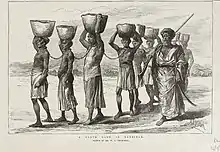
.jpg.webp)
